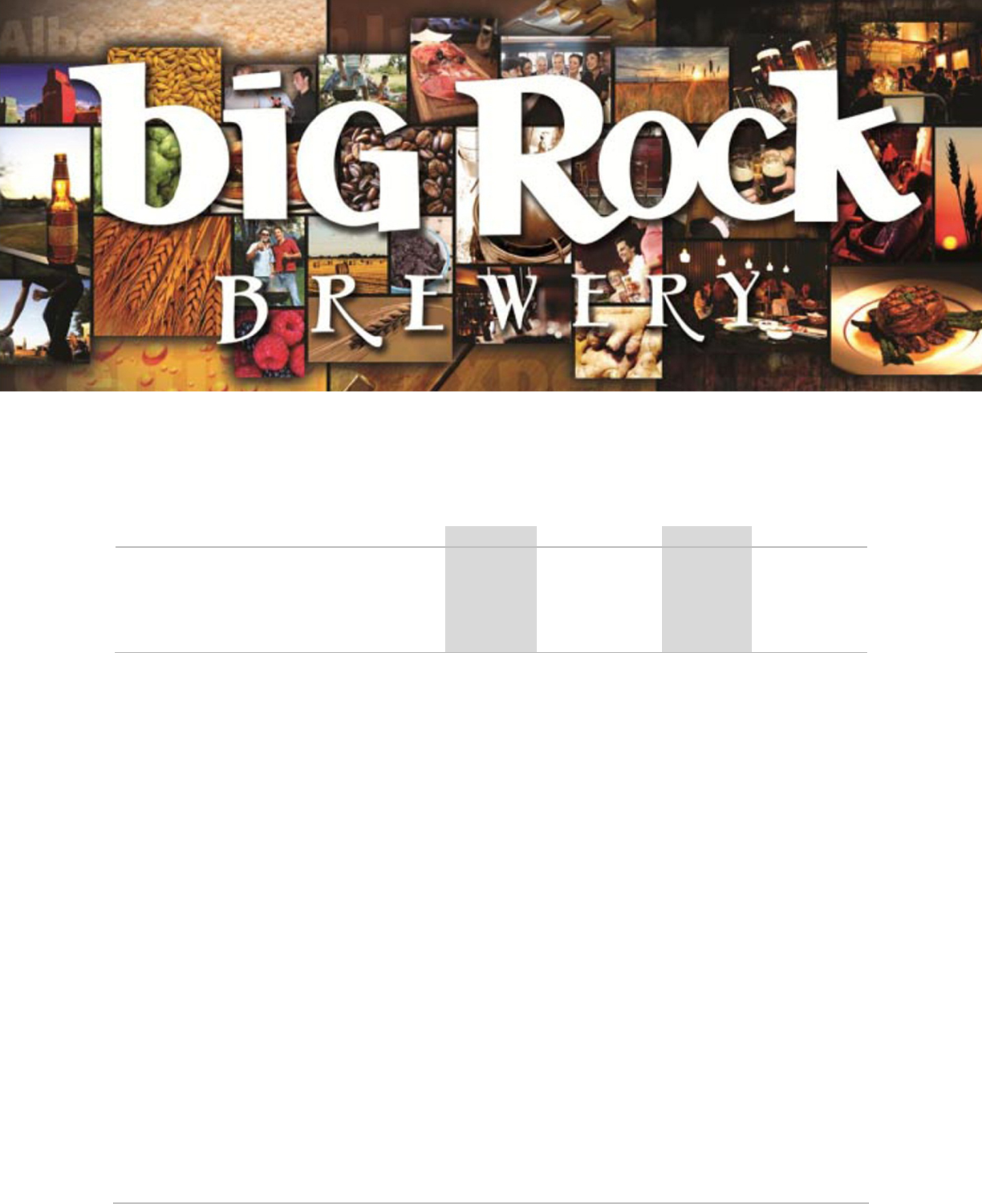
Big Rock Brewery Inc. Page 1 of 19 Q2 - 2016
BIG
ROCK BREWERY INC.
QUARTERLY REPORT
SECOND
QUARTER 2016 HIGHLIGHTS
Three months ended
June 30
Six months ended
June 30
$ thousands (unless otherwise stated)
2016
2015
2016
2015
Sales volumes (hectolitres or hl)
57,084 50,051 99,228 84,032
Net revenue 12,291 11,105 21,335 18,242
Operating profit (loss)
656 (304) (462) (1,135)
Net income (loss)
382 (473) (400) (1,097)
Earnings (loss) per share (basic and diluted)
$ 0.06 $ (0.07) $ (0.06) $ (0.16)
MANAGEMENT’S DISCUSSION AND ANALYSIS
The following is Management’s Discussion and Analysis (“MD&A”) of the financial condition and results
of operations of Big Rock Brewery Inc. (the “Corporation” or “Big Rock”) for the six months ended June
30, 2016, as compared to the same period in 2015.
This MD&A should be read in conjunction with the unaudited consolidated financial statements of the
Corporation and accompanying notes as at and for the six months ended June 30, 2016 (the “Financial
Statements”) and in conjunction with the December 30, 2015 audited consolidated financial statements
and MD&A contained within our 2015 Annual Report. The financial statements have been prepared
using International Financial Reporting Standards (“IFRS”). All amounts are reported in thousands of
Canadian dollars and comparative figures have been restated using IFRS, unless otherwise noted.
Readers should also read the “Forward-Looking Information” contained at the end of this document.
The MD&A is dated August 4, 2016.
CORPORATE
PROFILE
Big Rock Brewery—headquartered in Calgary, Alberta—produces premium, all-natural craft beers. As
Canada's leading craft brewer, Big Rock has a broad family of permanent ales and lagers, the Rock
Creek series of craft ciders, and a continually changing variety of seasonal and limited-edition beers.
Big Rock stands out as a Canadian producer, marketer, and distributor of premium quality specialty
craft beers. The Corporation has sales and distribution facilities in Calgary and Edmonton, sales staff
resident in Alberta, British Columbia, Saskatchewan, Manitoba and an agency arrangement for product
sales in Ontario. Big Rock products are sold across Canada and also exported to Korea.

Big Rock Brewery Inc. Page 2 of 19 Q2 - 2016
In April 2015, Big Rock expanded its physical presence to British Columbia (“BC”) when it officially
opened its brewery and eatery in Vancouver’s thriving craft beer district. This combined brewery and
brewpub serves on-premise consumers in downtown Vancouver and provides distribution for Big Rock’s
beers throughout BC.
INDUSTRY
TRENDS AND INDICATORS
The beer industry in Canada has become increasingly polarized, with growth occurring in value-priced
products at one end of the spectrum and in premium craft beers at the other end. This growth is
largely at the expense of products in the middle of the spectrum, which have been declining steadily
over the past several years. In Alberta specifically, the ongoing difficult economic conditions have
caused consumer demand to move to more value-priced products. Additionally, there is significantly
more competitive activity in Alberta than in other Canadian markets, as represented by faster growth
in the number of products listed in Alberta than the growth in sales volumes. In other major craft beer
markets, such as BC and Ontario, volume growth in craft beer has outpaced growth in product listings.
For the three and six months ended June 30, 2016, Big Rock grew volumes and gross profit nationally,
including in Alberta, the region where the fierce competition in the craft beer industry has been most
keenly felt. This is mainly due to the success of new private label beers which were launched late last
year. These products more closely align with the tastes of contemporary drinkers together with the
rebranding of AGD, Big Rock’s most approachable lager.
The enthusiastic response to the rebranding and relaunching of these lower-priced products has
compressed average margins. Additionally, margins in Alberta remain under sustained pressure as a
result of two changes to markup rates in 2015, which combined represented a 20.5% increase in Alberta
Gaming and Liquor Commission (“AGLC”) markup rates as compared to the previous year. This
increased beer and cider costs to consumers, which hampered Big Rock’s ability to implement a
planned price increase to cover rising input costs. The Corporation has not introduced a general price
increase in Alberta since November 2012.
Subsequent changes announced on July 12 and July 28, 2016 will replace Alberta’s graduated mark-up
rate with a flat rate of $1.25 per litre plus a new grant program for Alberta breweries that will be
administered by Alberta Agriculture and Forestry. These changes are due to take effect on August 5,
2016. Although the combined impact of the flat mark-up rate and the grant program is expected to
result in an effective net rate that is not materially different from the graduated rate which has
applied to Big Rock’s business in Alberta, the longer-term implications are being assessed.
In Ontario, Big Rock has been building brand awareness in anticipation of the forthcoming brewery and
restaurant, including sales and marketing initiatives and collaboration events. In addition to raising Big
Rock’s profile, these activities have translated to a year-to-date 22% increase in sales volumes
compared to the same period in 2015. The Etobicoke brewery is expected to commence operations
during the third quarter with the Liberty Village brewpub following in the fourth quarter.

Big Rock Brewery Inc. Page 3 of 19 Q2 - 2016
SELECTED QUARTERLY FINANCIAL INFORMATION
The following is a summary of selected financial information of the Corporation for the last eight
completed quarters:
2016 2015 2014
$ thousands (unless
otherwise stated)
Q2 Q1 Q4 Q3 Q2 Q1 Q4 Q3
Sales volumes (hl) 57,084 42,143 42,787 55,132 50,051 33,980 39,194 48,376
Net revenue 12,291 9,044 9,642 11,834 11,105 7,137 8,638 10,556
Operating profit (loss) 656 (1,118) (55) 104 (304)
(831) (224) 1,017
Net income (loss) 382 (782) (54) 76 (473)
(624) (106) 764
Per hl net revenue 215.31 214.60 225.35 214.65 221.87 210.04 220.39 218.21
Per hl cost of sales 117.88 129.53 124.57 120.11 126.21 109.95 121.88 109.70
Per hl selling expenses 58.53 71.73 73.36 65.37 75.04 80.08 73.17 64.87
Per hl general and
administrative
25.65 35.83 28.12 25.94 23.40 41.17 29.01 21.08
Per hl operating profit (loss) 11.49 (26.53) (1.29) 1.89 (6.07) (24.46) (5.72) 21.02
Per hl net income (loss) 6.69 (18.56) (1.26) 1.38 (9.45) (18.36) (2.70) 15.79
Earnings per share (basic
and diluted)
$ 0.06 $ (0.11) $ (0.01) $ 0.01 $(0.07) $ (0.09) $ (0.02) $ 0.11
Dividends per share $ 0.00 $ 0.00 $ 0.00 $ 0.00 $ 0.00 $ 0.00 $ 0.20 $ 0.20
Big Rock experiences seasonal fluctuations in volumes, net sales revenue and net income with the
second and third quarters typically being the highest and the first and fourth being the lowest. These
seasonal variations are dependent on numerous factors, including weather, timing of community
events, consumer behaviour, customer activity and overall industry dynamics, specifically in western
Canada. The selected quarterly information is consistent with these expectations and industry trends.
RESULTS
OF OPERATIONS
For the three months ended June 30, 2016, Big Rock’s net revenue from beer and cider sales increased
11.5% and sales volumes increased 14.1% as compared to the same period in 2015.
For the six months ended June 30, 2016, Big Rock’s net revenue from beer and cider sales increased
15.3% and sales volumes increased 18.1% as compared to the same period in 2015.
For both the three and six months ended June 30, 2016, volumes increased due primarily to the
increase in sales of the entry-level all-natural lager, AGD, market success of new private label products
and targeted limited-time offer (“LTO”) activity.
Net income for the six months ended June 30, 2016 included $413 of costs associated with the
establishment of the forthcoming Ontario Etobicoke brewery and Toronto brewpub which will be
located in Toronto’s vibrant Liberty Village.
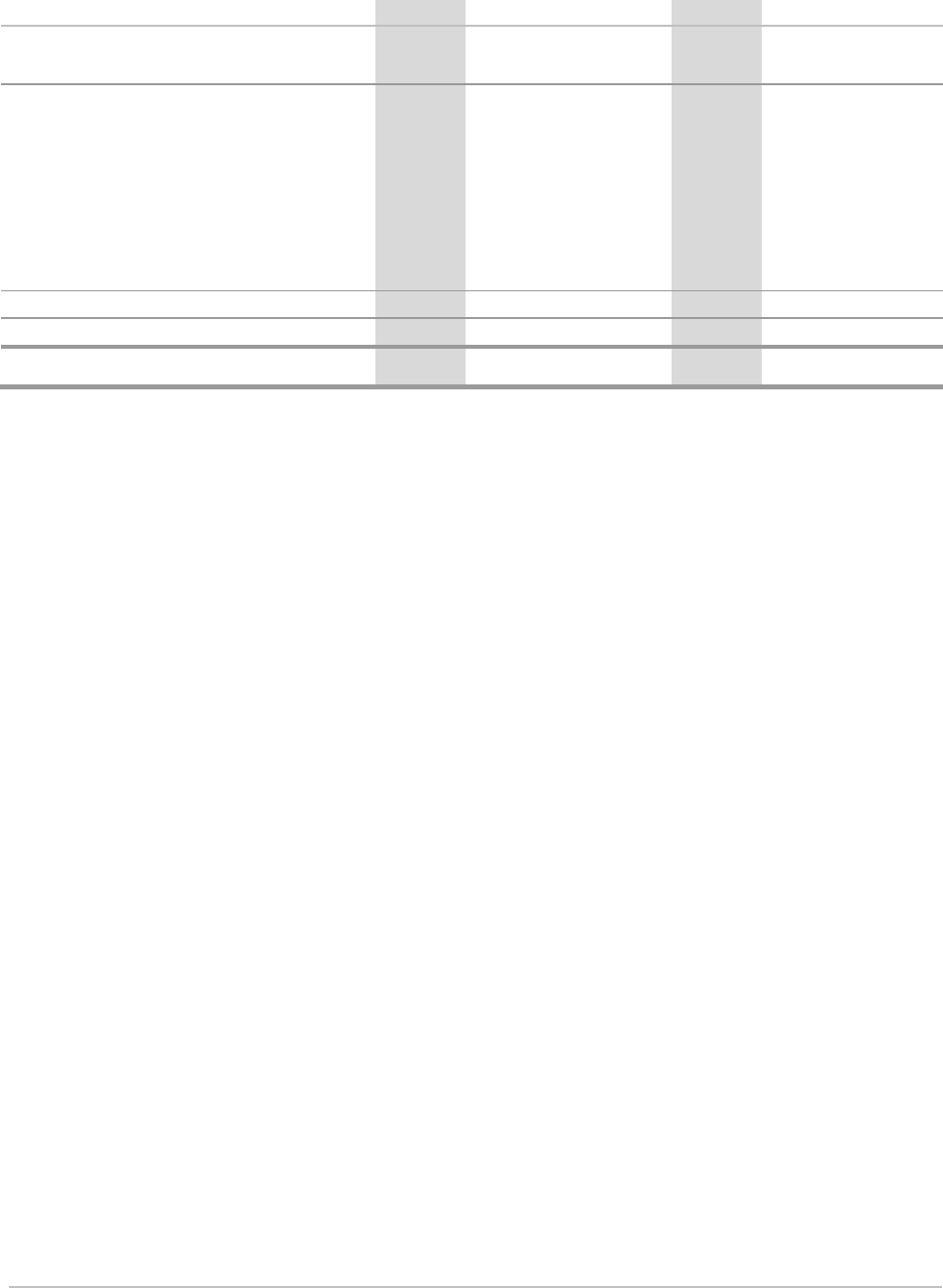
Big Rock Brewery Inc. Page 4 of 19 Q2 - 2016
Gross Profit
Three months ended
June 30
Six months ended
June 30
$ thousands (unless otherwise stated)
2016 2015 Change 2016 2015 Change
Wholesale revenue 11,746 10,532 1,214 20,294 17,596 2,698
Retail revenue
545 573 (28) 1,041 646 395
Net sales revenue
12,291 11,105 1,186 21,335 18,242 3,093
Wholesale cost of sales:
Ingredients and packaging materials
3,283 3,144 139 5,774 5,066 708
Labour
1,313 1,191 122 2,787 2,399 388
Overhead
1,214 865 349 2,027 1,574 453
Inventory movement
(14) 74 (88) (265)
(460) 195
Depreciation
481 467 14 913 865 48
Retail cost of sales
452 576 (124) 952 609 343
Cost of sales
6,729 6,317 412 12,188 10,053 2,135
Gross profit 5,562 4,788 774 9,147 8,189 958
Sales volumes (hl) 57,084 50,051 7,033 99,228 84,032 15,196
Net sales revenues include wholesale product sales for beer and cider, together with retail restaurant
and store sales from Big Rock’s Vancouver and Calgary locations.
Net sales revenue increased $1,186 (10.7%) and $3,093 (17.0%) for the three months and six months
ended June 30, 2016, respectively, compared to the same periods in 2015. The increases were mainly
attributable to increased beer and cider revenue on increased sales volumes. For the three and six
months ended June 30, 2016, beer and cider revenue increased by $1,214 and $2,698, respectively,
which was less than the increase in sales volumes due to the shift in the product mix towards lower
priced and private label brands. Geographically, Alberta and BC continued to represent the largest
shares of the Corporation’s sales.
For the three and six months ended June 30, 2016, total cost of sales increased by $412 and $2,135
compared to the same periods last year, as described below:
Costs relating to ingredients and packaging materials increased $139 for the quarter and $708
for the year to date June 30, 2016 due to increased brewing volumes and higher priced
ingredients.
When compared to the same periods in 2015, labour charges for the second quarter of 2016
increased $122 and for the year to date increased $388, primarily due to increased headcount
and severance costs arising from restructuring in Calgary.
Overhead costs include utilities, repairs and maintenance and other production related
amounts, which are primarily fixed in nature. Overhead costs increased by $349 and $453 for
the three and six months ended June 30, 2016, respectively, when compared to the same
periods in 2015. The increases are mainly due to increases in utilities charges, lease expenses
and other production consumables.
Inventory valuation comprises timing differences relating to the absorption of production costs
into finished goods inventory on the statement of financial position, and the eventual charge to
income for those costs as finished goods inventory is sold. Additionally, it includes the
absorption of changes in standard cost to inventory. For the quarter, charges relating to
inventory movement decreased by $88 and increased by $195 for the year to date, compared
with the same periods last year.
Big Rock includes depreciation
charges on production equipment used to convert raw materials
to finished goods as part of its cost of sales and finished goods inventory. Depreciation

Big Rock Brewery Inc. Page 5 of 19 Q2 - 2016
increased $14 and $48 for the three months and six months ended June 30, 2016, respectively,
compared with the same periods last year. The increases were driven by inventory movement
as well as machinery additions.
On a per hectolitre basis, cost of sales decreased by $4.74 per hl (4.1%) for the three months ended
June 30, 2016 compared to the same period in 2015. For the six months ended June 30, 2016, cost of
sales increased by $0.84 per hl (0.7%). Decreased overhead costs was the primary driver of the
decrease for the quarter, while inventory movement was the primary driver of the increase for the
year to date, as detailed in the following table:
Per hectolitre cost of sales
Three months ended
June 30
Six months ended
June 30
2016 2015 Change 2016 2015 Change
Net wholesale sales revenue 205.77 210.43 (4.66) 204.52 209.40 (4.88)
Wholesale cost of sales:
Ingredients and packaging materials
57.51 62.82 (5.31) 58.19 60.29 (2.10)
Labour
23.00 23.80 (0.80) 28.09 28.55 (0.46)
Overhead
21.27 17.27 4.00 20.42 18.73 1.69
Inventory movement
(0.25)
1.48 (1.73) (2.67) (5.47)
2.80
Depreciation
8.43 9.33 (0.90) 9.20 10.29 (1.09)
Wholesale cost of sales
109.96 114.70 (4.74) 113.23 112.39 0.84
Selling expenses
Three months ended
June 30
Six months ended
June 30
$ thousands (unless otherwise stated)
2016 2015 Change 2016 2015 Change
Selling:
Delivery and distribution
967 921 46 1,694 1,574 120
Salaries and benefits
860 776 84 1,712 1,583 129
Marketing
294 290 4 558 506 52
Regional sales
960 1,381 (421) 1,962 2,220 (258)
Community sponsorship and other 260 388 (128) 438 594 (156)
Total selling expenses 3,341 3,756 (415) 6,364 6,477 (113)
Selling expenses have decreased for the quarter by $415 and $113 for the six months ended June 30,
2016, when compared to the same periods in the prior year, as detailed below:
Delivery and distribution costs increased $46 in the quarter and $120 for the six months ended
June 30, 2016 primarily as a result of higher volumes delivered.
Salaries and benefit costs increased by $84 for the second quarter and $129 for the year to due
to increases in marketing headcount.
Marketing increased $4 in the quarter and $52 on a year to date basis primarily as a result of
increased advertising activity and market research.
Regional sales expenses, when compared to the same periods in the prior year, decreased by
$421 for the quarter and $258 for the year to date mainly as a result of reduced sales program
activity and lower promotional materials spending.
Community sponsorship and other expenses decreased $128 and $156 for the three and six
months ended June 30, 2016, respectively, due to the timing of sponsorship related payments.
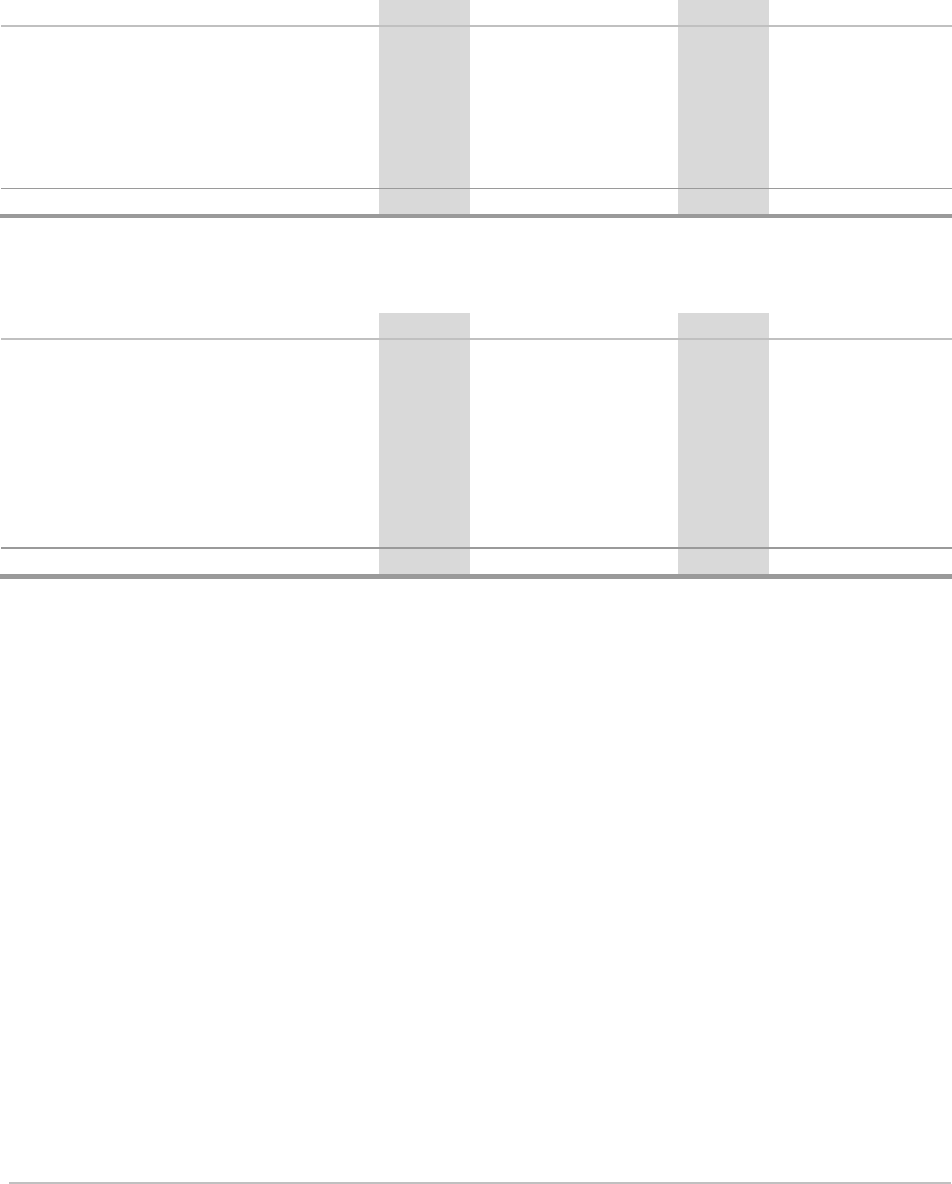
Big Rock Brewery Inc. Page 6 of 19 Q2 - 2016
On a per hectolitre basis, selling expenses decreased by $16.51 per hl (22%) for the three months ended
June 30, 2016 compared to the same period in 2015. For the six months ended June 30, 2016, selling
expenses decreased by $12.95 per hl (16.8%). Decreased regional sales and community expenses were
primary drivers of the decrease, as detailed in the following table:
Per hectolitre selling expenses
Three months ended
June 30
Six months ended
June 30
2016 2015 Change 2016 2015 Change
Selling:
Delivery and distribution
16.94 18.40 (1.46) 17.07 18.73 (1.66)
Salaries and benefits
15.07 15.50 (0.43) 17.25 18.84 (1.59)
Marketing
5.15 5.79 (0.64) 5.62 6.02 (0.40)
Regional sales
16.82 27.60 (10.78) 19.78 26.42 (6.64)
Community sponsorship and other
4.55 7.75 (3.20) 4.41 7.07 (2.66)
Selling expenses
58.53 75.04 (16.51) 64.13 77.08 (12.95)
General and Administrative expenses
Three months ended
June 30
Six months ended
June 30
$ thousands (unless otherwise stated)
2016 2015 Change 2016 2015 Change
General and Administrative:
Salaries and benefits 767 578 189 1,541 1,217 324
Professional fees
155 138 17 316 314 2
Building maintenance and taxes
238 128 110 501 348 153
Office, administrative and other
179 220 (41)
349 407 (58)
Reporting and filing fees 32 25 7 74 82 (8)
Insurance 57 62 (5)
112 119 (7)
Bank charges 36 20 16 81 83 (2)
Total general and administrative expenses 1,464 1,171 293 2,974 2,570 404
For the three months and six months ended June 30, 2016, general and administrative expenses
increased by $293 and $404 when compared with the same periods in 2015 as detailed below:
Salaries and benefit costs increased by $189 for three months ended June 30, 2016 when
compared to the same period in 2015 primarily as a result of the timing of accruals under Big
Rock’s bonus plan and $324 for the six months ended June 30, 2016 when compared to the
same period in 2015 as a result of adjustments to the valuation of awards under the
Corporation’s stock appreciation rights (“SAR”) program.
Professional fees, which include legal, audit, tax, accounting and other advisory and consulting
services, were $17 higher for the second quarter and $2 higher for the year to date, compared
to the same periods last year, primarily due to slight increases in tax and consulting fees.
Building maintenance and taxes increased $110 and $153 for the three and six months ended
June 30, 2016 when compared to the 2015 comparative periods, due to an increase in building
and utilities expenses related to the Ontario sites.
Office, administration and other decreased $41 and $58 for the three and six months ended
June 30, 2016 when compared to the 2015 comparative periods, due to Big Rock Vancouver
pre-opening costs no longer being included in the balance as they were in 2015. This was offset
slightly by the inclusion of start-up costs incurred for the establishment of the Toronto
brewpub.
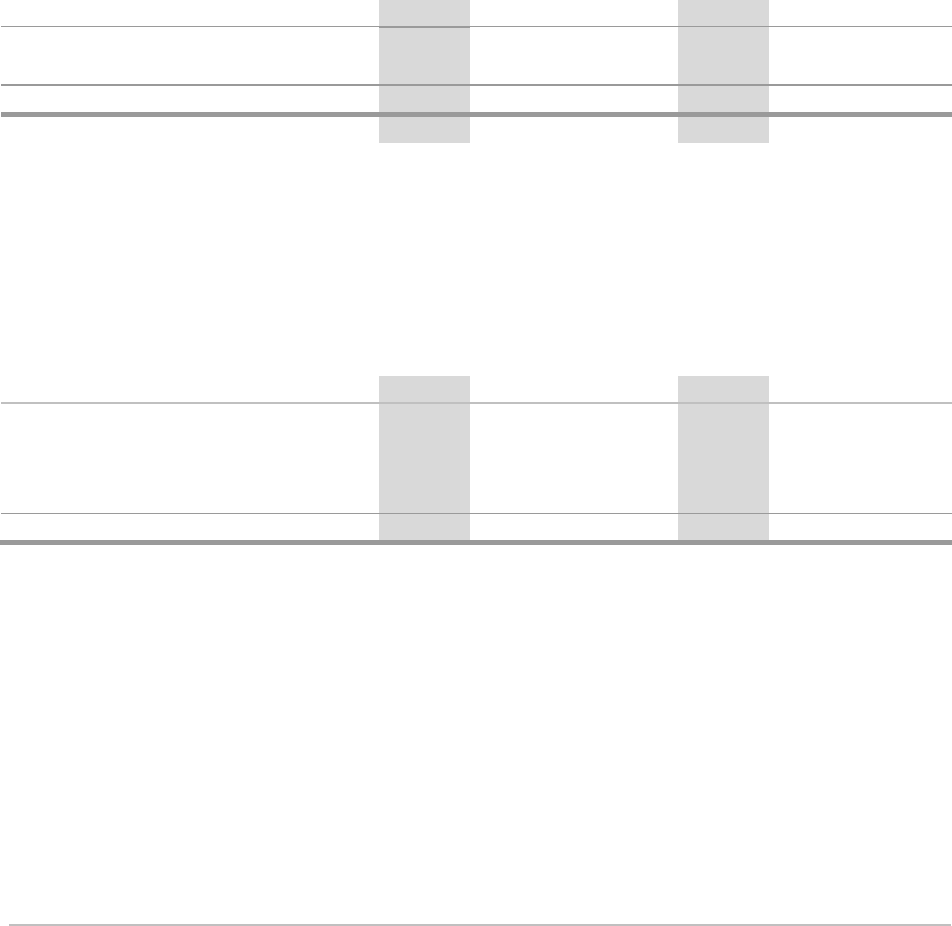
Big Rock Brewery Inc. Page 7 of 19 Q2 - 2016
Reporting and filing fees increased $7 for the quarter and decreased $8 for the six months
ended June 30, 2016, due to timing of TSX filing fees.
Bank charges increased $16 for the three months and decreased $2 for the year to date ended
June 30, 2016 when compared to the same periods last year as a result of withdrawals on Big
Rock’s term loan and operating loan facilities during the quarter.
For the three months ended June 2016, excluding $139 (2015 - $108) of expenses related to share
based compensation and $206 (2015 - $91) costs for the new Toronto facilities, general and
administrative expenses would have increased by $147 (15.1%) compared to the same period in 2015.
For the six months ended June 2016, excluding $364 (2015 - $4) of expenses related to share based
compensation and $413 costs for the new Toronto facilities (2015 - $386 costs for Vancouver and
Toronto), general and administrative expenses would have increased by $17 (0.8%) compared to the
same period in 2015.
Finance expenses
Three months ended
June 30
Six months ended
June 30
$ thousands (unless otherwise stated)
2016 2015 Change 2016 2015 Change
Interest on long-term debt 91 26 65 136 26 110
Interest on operating facility
1 46 (45)
13 63 (50)
Total finance expenses 92 72 20 149 89 60
Weighted average effective interest rate 6.45% 4.20% 5.58% 4.24%
The principal amount of long-term debt and bank indebtedness was $7,251 as at June 30, 2016
compared to $6,351 as at June 30, 2015. The interest rates applicable to all loans and borrowings are
based on the lender’s prime rate. The increase in interest expense for the three and six months ended
June 30, 2016 compared to the same periods last year is due to changes in the mix of facilities
combined with higher balances outstanding.
Depreciation and amortization
Three months ended
June 30
Six months ended
June 30
$ thousands (unless otherwise stated)
2016 2015 Change 2016 2015 Change
Depreciation included in wholesale cost of sales
481 467 14 913 865 48
Depreciation included in retail cost of sales
37 — 37 74 — 74
Depreciation - other
61 156 (95) 191 260 (69)
Amortization
40 9 31 80 17 63
Total
619 632 (13) 1,258 1,142 116
For the quarter ended June 30, 2016 depreciation expense included in cost of sales increased by $51
while for the six months ended, depreciation expense included in cost of sales increased by $122
compared with the same period last year due to asset additions and inventory movement.
Other depreciation, which relates to non-production assets, decreased primarily due to
reclassifications of Big Rock’s Vancouver restaurant assets since June 2015.
Amortization expense, which relates to intangible assets, which include software, naming rights and
website costs, increased due to software additions since June 2015.

Big Rock Brewery Inc. Page 8 of 19 Q2 - 2016
Other
Three months ended
June 30
Six months ended
June 30
$ thousands (unless otherwise stated)
2016 2015 Change 2016 2015 Change
Other income 3 142 (139) 82 143 (61)
Other expenses
— — — — — —
Other income includes rental income arising from use of yard space and gains or losses on asset
disposals.
Income taxes
Three months ended
June 30
Six months ended
June 30
$ thousands (unless otherwise stated)
2016 2015 Change 2016 2015 Change
Deferred income tax expense (recovery) 260 79 181 18 (89) 107
Current income tax expense (recovery)
(75) 160 (235) (147)
105 (252)
A current income tax recovery of $75 was recorded for the three months ended June 30, 2016 (2015 –
expense of $160) bringing the year to date current tax recovery to $147 (2015 – expense of $105).
These taxes arise from the transitional provisions on the taxation of partnership deferral structures
which are expected to conclude in 2017.
During the three months ended June 30, 2016, the Corporation recorded a deferred income tax
expense of $260, bringing the year to date deferred tax expense to $18 compared to a recovery of $89
for the same six month period last year.
The deferred income tax provision differs from the statutory rate of 26.91% (2015 – 26.04%) due to
permanent differences between the carrying amounts of assets and liabilities for accounting purposes
and the amounts used for income tax purpose, as well as the effect of non-deductible amounts.
FINANCIAL CONDITION
The following chart highlights significant changes in the Consolidated Balance Sheets from December
30, 2015 to June 30, 2016:
$ thousands (unless otherwise stated)
Increase/
(Decrease)
Primary factors explaining change
Property, plant and equipment 1,924
AB and ON brewery and machinery additions, net of
amortization
Intangible assets (57) Amortization in excess of additions
Inventories 391
Increase in raw materials and finished goods due to
increased Big Rock Vancouver production and stockpiling
in anticipation of summer seasonal demand
Accounts receivable
1,059
Higher day sales outstanding from AB combined with
increased GST receivable
Prepaid expenses and other
27
Increase in prepaid insurance expenses and sponsorship
deposits, offset by a reduction in machinery deposits
Long term debt 2,317 Draws on term loan
Deferred income taxes 18 Tax effect of changes in temporary differences
Share based payments liability 285
Higher SAR valuation
Current income taxes 121 Tax payments in 2015
Accounts payable and accrued liabilities 1,139 Timing of supplier payments
Bank indebtedness (202)
Combined balance of certain bank accounts in overdraft
position moved towards a debit position

Big Rock Brewery Inc. Page 9 of 19 Q2 - 2016
LIQUIDITY AND CAPITAL RESOURCES
Capitalization
$ thousands (unless otherwise stated)
June 30,
2016
December 30,
2015
Bank indebtedness (cash)
(311) (540)
Total debt 7,251 5,136
Shareholders’ equity:
Shareholders’ capital
113,121 113,121
Contributed surplus
1,334 1,255
Accumulated deficit
(77,236) (76,836)
Total shareholders’ equity
37,219 37,540
Total capitalization (total debt plus
shareholders’ equity, net of cash balances)
44,159 42,136
Total debt to capitalization ratio 16.4% 12.2%
Capital Strategy
The Corporation includes as capital its common shares plus short-term and long-term debt, net of cash
balances, and has no externally imposed capital requirements. The Corporation’s objectives are to
safeguard the Corporation’s ability to continue as a going concern, in order to support the
Corporation’s normal operating requirements and to maintain a flexible capital structure which
optimizes the costs of capital at an acceptable risk. This allows management to maximize the
profitability of its existing assets and create long-term value and enhance returns for its shareholders.
The Corporation manages the capital structure through prudent levels of borrowing, cash-flow
forecasting and working capital management, and makes adjustments to it in light of changes in
economic conditions and the risk characteristics of the underlying assets. In order to maintain or adjust
the capital structure, the Corporation may issue new shares, issue new debt, acquire or dispose of
assets or adjust the amount of cash and cash equivalents. In order to facilitate the management of its
capital requirements, the Corporation prepares annual expenditure budgets, which are approved by the
Board of Directors. These budgets are updated as necessary depending on various factors, including
capital deployment, results from operations, and general industry conditions.
In addition, the Corporation monitors its capital using ratios of (i) earnings before interest, taxes,
depreciation and amortization (“EBITDA”) to net debt and (ii) EBITDA to interest, debt repayments and
dividends. EBITDA to interest, debt repayments and dividends is calculated by dividing the combined
interest, debt repayments and dividend amounts by EBITDA and EBITDA to net debt is calculated by
dividing debt minus cash by EBITDA. EBITDA is a non-GAAP measure. For a reconciliation of EBITDA to
net income, the nearest GAAP measure, see Cash Flows—Financing Activities later in this MD&A.
These capital policies provide Big Rock with access to capital at a reasonable cost.
As discussed later in this MD&A, all of the borrowing facilities have financial tests and other covenants
customary for these types of facilities and must be met at each reporting date.
Shareholders’ Capital
# of shares
$ Amount
(thousands)
As at December 30, 2015 and June 30, 2016 6,875,928 113,121
Big Rock is authorized to issue an unlimited number of common shares with no par value.
The Corporation’s shares trade on the Toronto Stock Exchange under the symbol BR. As at August 4,
2016 there were 6,875,928 issued and outstanding shares and the closing price was $5.56 per share.
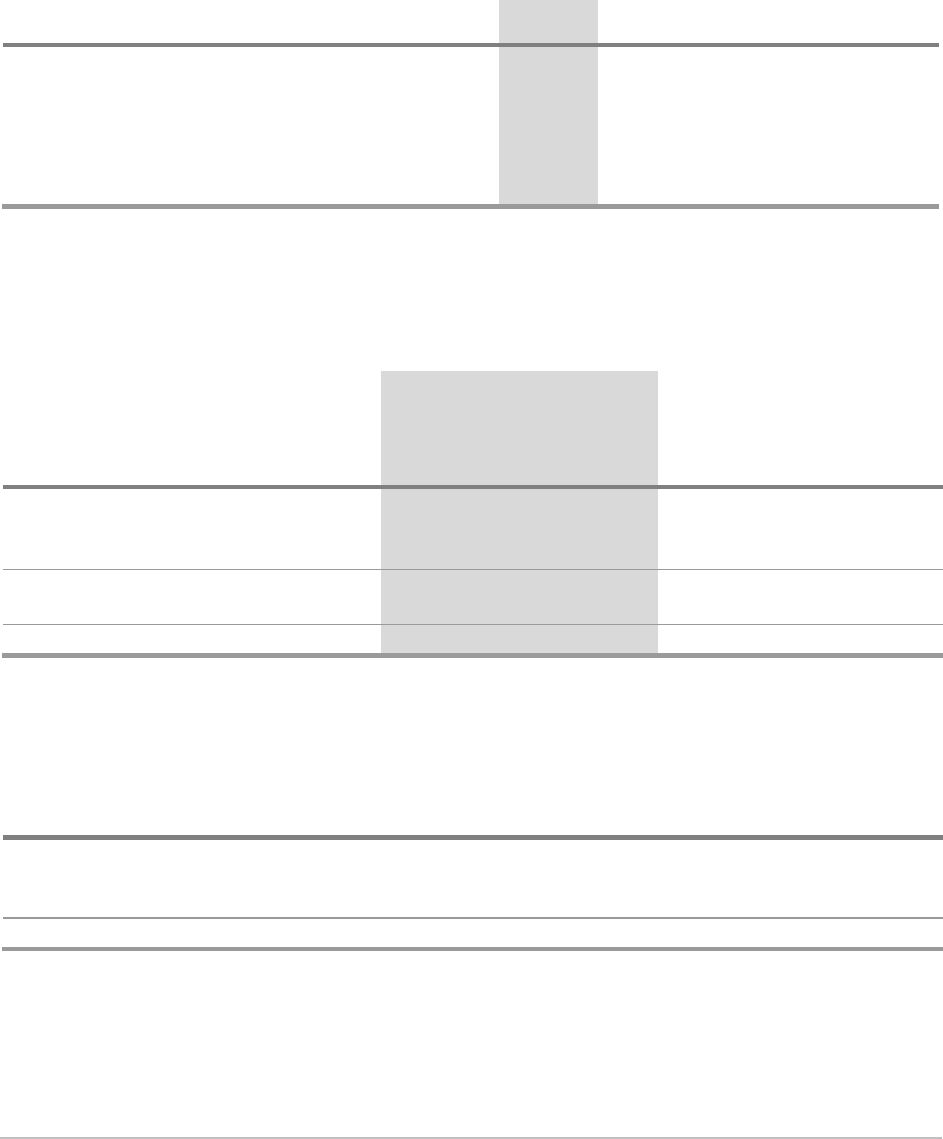
Big Rock Brewery Inc. Page 10 of 19 Q2 - 2016
Based upon 6,875,928 issued shares, the Corporation has an approximate market capitalization of $38.2
million.
Share Based Compensation Plan
The weighted average fair value of the options issued during the three months ended June 30, 2016
was estimated using the Black-Scholes option pricing model.
The weighted average assumptions used for the calculation were:
March
2016
September
2015
May
2015
September
2014
Weighted average fair value per
option
1.35 1.33 1.60 1.54
Risk-free interest rate (%) 0.65 0.65 0.89 1.42
Expected life of the options (years)
4 4 4 4
Dividend rate (%)
0.00 0.00 0.00 5.06
Volatility in the price of the
Corporation's shares (%)
34.7 29.4 28.7 22.4
A share-based compensation charge of $79 (2015 - $94) for the options granted in the six months ended
June 30, 2016 was recognized in statement of comprehensive income. Share-based compensation costs
have been included in general and administrative expenses.
The following is a summary of option transactions under the Corporation’s share option plan:
2016 2015
# of options
Weighted
average
exercise
price # of options
Weighted
average
exercise
price
Balance, beginning of year
517,000 $ 13.10 508,000 $ 15.22
Expired (17,500) 16.60 — —
Issued
58,500 5.12 — —
Balance, March 31
558,000 $ 12.15 508,000 $ 15.22
Issued — — 58,500 $ 7.46
Balance, June 30
558,000 $ 12.15 566,500 $ 14.42
The following table summarizes information about share options outstanding and exercisable at June
30, 2016:
Exercise price
# of Options
outstanding at
June 30, 2016
Weighted
average
remaining
contractual
life (years)
Weighted
average
exercise
price
# of Options
exercisable at
June 30, 2016
$5.12 to $12.19 193,000 3.88 $ 6.65 193,000
$12.20 to $14.98 189,500 1.12 $ 13.88 189,500
$14.99 to $18.06 175,500 2.70 $ 16.34 175,500
Balance, June 30 558,000 2.57 $ 12.15 558,000
In March 2012, the Corporation introduced a share appreciation rights (“SAR”) plan as a component of
overall compensation of directors, officers and employees. These SARs vest immediately and are
exercisable for five years thereafter.
At the end of each reporting period, the fair value of the SARs, as determined by the Black-Scholes
model, is recorded as a liability on the balance sheet and recorded as compensation expense.
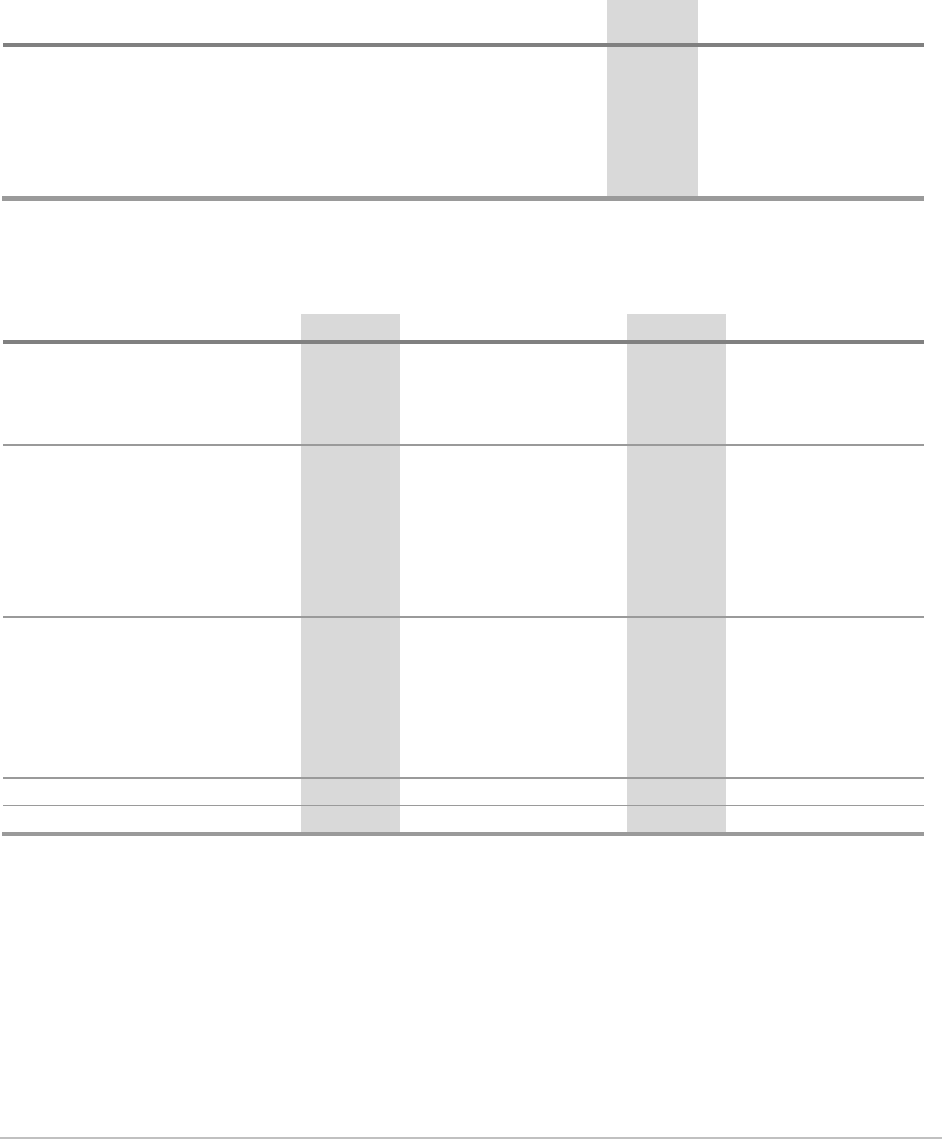
Big Rock Brewery Inc. Page 11 of 19 Q2 - 2016
As at June 30, 2016, 470,900 SARs were outstanding (December 30, 2015 – 391,900). During the three
months ended June 30, 2016, no SARs were issued (2015 – 57,000), no SARs were exercised (2015 – nil)
and no SARs expired (2015 – nil). As at June 30, 2016, the fair value of the SARs was calculated and
resulted in a liability of $419 (December 30, 2015 - $134) and an expense of $285 being recorded in
general and administrative expenses (December 30, 2015 – recovery of $82).
At June 30, 2016, the weighted average fair value of the SARs issued at the grant date was estimated
using the Black-Scholes option pricing model. The weighted average assumptions used for the
calculations were:
March
2016
September
2015
May
2015
Weighted average fair value per SAR
2.31 1.92 1.31
Risk-free interest rate (%)
0.56 0.55 0.54
Expected life of the SAR (years)
4.70 4.20 3.87
Dividend rate (%)
0.00 0.00 0.00
Volatility in the price of the
Corporation's shares (%)
34.8 34.8 34.8
Cash Flows
Three months ended
June 30
Six months ended
June 30
$ thousands 2016 2015 Change 2016 2015 Change
OPERATING ACTIVITIES
Net income (loss) for the period,
adjusted for items not affecting cash
1,411 251 1,160 1,186 (123) 1,309
Net change in non-cash working
capital related to operations
(1,328)
(157) (1,171) (474) (1,527) 1,053
Cash provided by (used in) operating
activities
83 94 (11) 712 (1,650) 2,362
FINANCING ACTIVITIES
Increase (decrease) in bank
indebtedness
680 (527) 1,207 (202) 4,401 (4,603)
Dividend payments
— — — — (1,375) 1,375
Proceeds from long-term debt
367 1,950 (1,583) 2,317 1,950 367
Cash provided by financing activities
1,047 1,423 (376) 2,115 4,976 (2,861)
INVESTING ACTIVITIES
Purchase of property, plant and
equipment
(1,390)
(718) (672) (3,165) (3,651) 486
Purchase of intangibles
(15)
(37) 22 (23) (266) 243
Proceeds from sale of equipment
30 101 (71) 132 101 31
Cash used in investing activities
(1,375)
(654) (721) (3,056) (3,816) 760
Net change in cash (245)
863 (1,108)
(229) (490) 261
Operating Activities
Cash provided by operating activities for the three months ended June 30, 2016 totalled $83, a
decrease of $11 compared to the same period last year, mainly as a result of lower non-cash working
capital related to operations. Cash provided by operating activities for the six months ended June 30,
2015 totalled $712, an increase of $2,362 compared to the same period last year, due to the increase
in both net income and non-cash working capital.

Big Rock Brewery Inc. Page 12 of 19 Q2 - 2016
Financing Activities
Cash provided by financing activities for the three months ended June 30, 2016 decreased by $376
compared with the same period in 2015. The decrease is a result of fewer draws on long term debt.
This was offset slightly by the increase in bank indebtedness.
Cash provided by financing activities for the six months ended June 30, 2016 decreased by $2,861
compared with the same period in 2015 mainly due to lower draw on the operating facility, which
decreased bank indebtedness.
On March 29, 2016, Big Rock signed a commitment letter to revise and extend the existing $5 million
revolving operating loan facility and $6 million 5-year term loan facility which is available for general
operating purposes and funding capital expenditure requirements. For prime-based loans, interest will
be payable at the financial institution’s prime plus 2.0–4.0 percent; for guaranteed notes, the
acceptance fee is payable at 3.75 percent; and for letters of credit, the fee is payable at 3.75 percent
with a minimum fee of $100. Both facilities mature after a term of 5 years and any undrawn amounts
under the facility will expire on March 29, 2021, if no extension has been granted. Collateral for these
borrowings is a general assignment of Big Rock’s assets.
The facility imposes a number of positive and negative covenants on Big Rock, including the
maintenance of certain financial ratios. At December 30, 2015 Big Rock was outside the required range
of one of its financial covenants and had received a waiver for that period and for the three months
ended June 30, 2016. Big Rock was in compliance with all other covenants at June 30, 2016.
As at June 30, 2016, $3,700 (December 30, 2015 - $1,850) was drawn on the term loan facility and
$1,045 (December 30, 2015 - $1,247) was outstanding on the operating loan facility.
On July 9, 2015 Big Rock signed a commitment letter for a $2.5 million lease financing facility which is
available to finance the purchase of equipment relating to Big Rock’s Ontario expansion. Interest will
be charged at the financial institution’s prime plus 3.67 per cent. The facility matures after a term of 5
years. As at June 30, 2016, $2,506 (December 30, 2015 - $2,039) was drawn on the facility.
The calculation of EBITDA is a non-GAAP measure, whose nearest GAAP measure is net income with the
reconciliation between the two as follows:
$ thousands (unless otherwise stated)
Six months ended
June 30, 2016
Six months ended
June 30, 2015
EBITDA
$ 878
$ 150
Deduct: Depreciation & Amortization 1,258 1,142
Earnings (loss) before interest and taxes
(380) (992)
Deduct: Interest
149 89
Deduct: Income tax charge
(129) 16
Net income
$ (400) $ (1,097)
Investing Activities
For the three and six months ended June 30, 2016, capital spending, net of dispositions, was $1,375
and $3,056, respectively, compared to $654 and $3,816 for the same periods in 2015. Capital spending
for the quarter ended June 30, 2016, net of dispositions, included net cash received of $29 in respect
of kegs (2015 – net cash received of $4), $nil relating to land (2015 - $9), $19 (2015 – $38) for the
purchase of new vehicles, $1,188 (2015 – $436) for brewing and packaging equipment, $170 (2015 –
$50) relating to buildings and warehouses, $11 (2015 – $88) for the purchase of office furniture and
equipment, $1 for leasehold improvements (2015 - $nil), and $15 (2015 - $37) for the purchase of
intangible assets.
Capital spending, net of dispositions, for the six months ended June 30, 2016 included $8 for the
purchase of kegs (2016 – net cash received of $25), $3 relating to land (2015 - $9), $72 (2015 – $70) for
the purchase of new vehicles, $1,901 (2015 – $1,035) for brewing and packaging equipment, $998 (2015

Big Rock Brewery Inc. Page 13 of 19 Q2 - 2016
– $1,627) relating to buildings and warehouses, $50 (2015 – $834) for the purchase of office furniture
and equipment, $1 for leasehold improvements (2015 - $nil), and $23 for the purchase of intangible
assets (2015 - $266).
Cash Dividends
In March 2015, Big Rock announced the suspension of the Corporation’s quarterly dividend until further
notice.
In determining dividend levels, if any, in the future, the Board will consider the financial performance,
capital plans, growth opportunities, expectations of future economic conditions and other factors.
Since the level of dividends is highly dependent upon cash flow generated from operations, which
fluctuates significantly in relation to changes in financial and operational performance, commodity
prices, interest and exchange rates and many other factors, future dividends cannot be assured.
Dividends are subject to the risk factors described herein and in the Corporation’s public disclosure
documents including its current Annual Information Form.
CRITICAL ACCOUNTING ESTIMATES
Share-based compensation
The Corporation recognizes compensation expense on options with no cash settlement feature at time
of grant as well as on changes in the fair value of any outstanding SARs at each reporting date. Stock
based compensation expense with respect to options recognized during the six months ended June 30,
2016 was $79 (2015 – $94), while the expense recognized with respect to SARs was $285 (2015 –
recovery of $90) as discussed earlier in this MD&A.
Property, Plant and Equipment
Accounting for PP&E involves making estimates of the life of the assets, selecting an appropriate
method of depreciation and determining whether an impairment of the assets exists. These
assessments are critical due to their potential impact on income.
At each date of the statement of financial position, the Corporation reviews the carrying amounts of its
tangible and intangible assets to determine whether there is an indication that those assets have
suffered an impairment loss. If any such indication exists, the recoverable amount of the asset is
estimated in order to determine the extent of the impairment loss (if any). Where it is not possible to
estimate the recoverable amount of an individual asset, the Corporation estimates the recoverable
amount of the cash-generating unit to which the assets belong.
Recoverable amount is the higher of fair value less costs to sell and value in use. In assessing value in
use, the estimated future cash flows are discounted to their present value using a pre-tax discount rate
that reflects current market assessments of the time value of money and the risks specific to the asset.
If the recoverable amount of an asset (or cash-generating unit) is estimated to be less than its carrying
amount, the carrying amount of the asset (or cash-generating unit) is reduced to its recoverable
amount. An impairment loss is recognized immediately in the statement of comprehensive income.
Where an impairment loss subsequently reverses, the carrying amount of the asset (or cash-generating-
unit) is increased to the revised estimate of its recoverable amount, but so that the increased carrying
amount does not exceed the carrying amount that would have been determined had no impairment loss
been recognized for the asset (or cash-generating unit) in prior years.
Keg Deposits
The Corporation requires that customers pay a deposit for each keg purchased, which is subsequently
refunded to customers via invoice credits or cash payments when kegs are returned and these deposits
are reflected as a liability on the Corporation’s balance sheet. In the normal course of business there
are a percentage of kegs that are never returned for refund. As a result, the Corporation performs an

Big Rock Brewery Inc. Page 14 of 19 Q2 - 2016
analysis based on factors such as total kegs produced, current inventory rates and average keg
turnover. In addition, return percentages are calculated and tracked to estimate an average keg
turnover rate. Together this information is used to estimate a reasonable keg deposit liability at each
reporting date. Any adjustments required to the keg liability account are applied to revenue.
RISKS RELATED TO THE BUSINESS AND INDUSTRY
Big Rock operates in an environment that is both highly competitive and highly government regulated.
Due to the ongoing shifting effects of competition, the ability to predict future sales and profitability
with any degree of certainty is limited. It is also difficult to anticipate changes in government
regulation and legislation and the impact such changes might have on the Corporation’s operations.
There is a continuing entry of premium and super premium beers from other craft breweries and the
larger national and multi-national brewers with products that compete directly with craft beers. A
large number of imports are also being sold in the same markets where Big Rock competes for business.
With the large choice of craft brands now available, and the advertising initiatives of pseudo-craft
divisions of the major breweries, it is likely that competitive pressures on price will continue. As a
result, the selling price may vary more frequently.
Big Rock requires various permits, licenses, and approvals from several government agencies in order to
operate in its market areas. In Alberta, Big Rock’s largest market, the Alberta Gaming and Liquor
Commission provides the necessary licensing approvals. Other licenses have been obtained from various
other government authorities. Management believes that Big Rock is in compliance with all licenses,
permits, and approvals.
Each provincial authority has its own tax or “mark-up” structure by which fees are levied on brewers’
sales within that jurisdiction. These regulations may be changed from time to time, which may
positively or negatively impact Big Rock’s profitability.
In 2012, the Alberta government commenced a review of its mark-up rates and on March 26, 2015,
announced an increase in the mark-up rate applicable to Big Rock with an immediate corresponding
increase in the prices of the Corporation’s products. On October 27, 2015, the Alberta government
announced a change to mark-up rates applicable to Big Rock which slightly reduced the impact of the
previous increase. In July 2016, the Alberta government announced that, effective August 5, 2016, the
graduated mark-up scheme will be replaced with a flat-rate mark-up of $1.25 per litre plus a new grant
program for Alberta breweries to be administered by Alberta Agriculture and Forestry. It is currently
expected that the effective net rate of these programs will not be materially different to Big Rock than
the graduated mark-up program that they replace. As Alberta is Big Rock’s predominant market,
changes to this mark-up rate structure could have significant impacts on the Corporation’s financial
results and the Corporation will continue to assess the longer-term implications of these changes.
While the immediate impact is favourable to Big Rock, the longer-term implications are currently being
assessed.
Financial Risk
The Corporation’s principal financial instruments are its outstanding amounts drawn from its credit
facilities, which, after cash flow from operations, are its main source of financing. Other financial
assets and liabilities arising directly from its operations and corporate activities include cash, accounts
receivable, bank indebtedness, accounts payable, long term debt and distributions payable. The
primary risks arising from the Corporation’s financial instruments are credit risk, liquidity risk,
commodity price risk, interest rate risk and foreign exchange risk, each of which are discussed below.
Management manages and monitors these exposures to ensure appropriate measures are implemented
in a timely and effective manner.

Big Rock Brewery Inc. Page 15 of 19 Q2 - 2016
Credit Risk
Credit risk is the risk that the counterparty to a financial asset will default, resulting in the Corporation
incurring a financial loss.
Big Rock has a concentration of credit risk because a majority of its accounts receivable are from
provincial liquor boards, under provincially regulated industry sale and payment terms. The
Corporation is not exposed to significant credit risk as payment in full is typically collected by
provincial liquor boards at the time of sale and receivables are with government agencies. While
substantially all of Big Rock’s accounts receivable are from provincial government liquor authorities,
the timing of receipts of large balances may vary significantly from period to period. The majority of
product sold outside of Canada, which is included in GST and other receivables, is done so on a ‘Cash
on Delivery’ basis with no credit risk.
Credit risk associated with the potential non-performance by financial instrument counterparties has
been minimized through the careful selection of vendors, the development of long term vendor
relationships and the selective use of written arrangements to guarantee supply and payment terms.
Liquidity Risk
Big Rock’s principal sources of liquidity are its cash flows from operations and existing or new credit
facilities. Liquidity risk is mitigated by maintaining banking facilities, continuously monitoring forecast
and actual cash flows and, if necessary, adjusting levels of dividends to shareholders and capital
spending to maintain liquidity.
Management closely monitors the liquidity position and expects to have adequate sources of funding to
finance the Corporation’s operations.
Commodity Price Risk
The Corporation is exposed to commodity price risk in the areas of utilities (primarily electricity and
natural gas), malted barley, water, glass and aluminum, where fluctuations in the market price or
availability of these items could impact Big Rock’s cash flow and production. To minimize the impact of
this risk, the Corporation enters into contracts which secure supply and set pricing to manage the
exposure to availability and pricing.
Big Rock’s profitability depends on the selling price of its products to provincial liquor boards, which
set minimum price thresholds. Although prices are otherwise controlled by the Corporation, they are
subject to such factors as regional supply and demand, and to a lesser extent inflation and general
economic conditions. As beer and cider sales are the only source of revenue for the Corporation, a 5%
increase or decrease in these prices will result in a corresponding increase or decrease in revenue.
Interest Rate Risk
Big Rock is exposed to interest rate risk on the variable rate of interest incurred on the amounts due
under operating and credit facilities and on interest earned on bank deposits. The cash flow required
to service the interest on these facilities will fluctuate as a result of changes to market rates.
The Corporation has not entered into any derivative instruments to manage interest rate fluctuations;
however, management monitors interest rate exposure and given the relatively low expected rate of
change in prime interest rates feels the risk is immaterial. Big Rock evaluates the policies surrounding
interest rates on an as needed basis and is confident that this policy is sufficient based on current
economic conditions, combined with the minimal amount of debt required by the Corporation.
The fair value interest rate risk on bank deposits is insignificant as the deposits are short-term and the
fair value of the Corporation’s long-term debt does not change as interest rates change.

Big Rock Brewery Inc. Page 16 of 19 Q2 - 2016
The weighted average interest rate incurred by the Corporation in the three and six months ended June
30, 2016 was 6.45% (2015 – 4.20%) and 5.58% (2015 – 4.24%) respectively.
Foreign Exchange Risk
The Corporation currently transacts with only a few foreign suppliers providing small amounts of goods
and thus has limited exposure to risk due to variations in foreign exchange rates. The Corporation has
not entered into any derivative instruments to manage foreign exchange fluctuations; however,
management monitors foreign exchange exposure.
The Corporation does not have any significant foreign currency denominated monetary liabilities.
For a more detailed discussion of risk factors that could materially affect Big Rock’s results of
operations and financial condition please refer to the Risk Factors section of the Corporation’s Annual
Information Form dated March 10, 2016 that is available on www.sedar.com.
FUTURE ACCOUNTING PRONOUNCEMENTS
IFRS Policies
The Corporation’s interim financial statements as at and for the three months ended June 30, 2016 and
2015 have been prepared using the IFRS standards and interpretations currently issued. Accounting
policies currently adopted under IFRS are subject to change as a result of new standards being issued
with an effective date of December 31, 2015 or prior. A change in an accounting policy used may result
in material changes to Big Rock’s reported financial position, results of operations and cash flows.
Future accounting pronouncements
The IASB has issued the following pronouncements:
Amendments to IAS 7 Statement of cash flows are effective for annual periods beginning on or
after January 1, 2017. The amendments clarify that entities shall provide disclosures that
enable users of financial statements to evaluate changes in liabilities arising from financing
activities.
Amendments to IAS 12 Income taxes are effective for annual periods beginning on or after
January 1, 2017. The amendments clarify several aspects of the standard including: deductible
temporary differences relating to unrealized losses on debt instruments, estimations of future
taxable profits, and how an entity assesses deferred tax assets.
IFRS 9 Financial Instruments has been amended, effective for annual periods beginning January
1, 2018. The amended standard replaces IAS 39 Financial Instruments: Recognition and
Measurement and all previous versions of IFRS 9. The standard requires classification of
financial assets on the basis of the reporting entity’s business model objectives for managing
those financial assets and the characteristics of the contractual cash flows. As a result, both
the classification and measurement of certain financial assets may change. Additionally, for
liabilities designated at fair value through profit and loss, fair value changes attributable to
changes in credit risk will be presented through other comprehensive income instead of net
income.
IFRS 15 Revenue from Contracts with Customers has been issued which will be required to be
adopted, with retrospective application, effective for annual periods beginning on or after
January 1, 2018. This standard establishes a five-step model that will apply to revenue earned
from a contract with a customer (with limited exceptions), regardless of the type of revenue
transaction or the industry. The standard also provides a model for the recognition and
measurement of sales of some non-financial assets (e.g., disposals of property, plant and
equipment).

Big Rock Brewery Inc. Page 17 of 19 Q2 - 2016
IFRS 16 Leases has been issued which will be required to be adopted effective for annual
periods beginning on or after January 1, 2019. This standard provides a single lessee accounting
model, requiring lessees to recognize assets and liabilities for all leases unless the lease term is
12 months or less or the underlying asset has a low value. Lessors continue to classify leases as
operating or finance, with IFRS 16’s approach to lessor accounting substantially unchanged
from its predecessor, IAS 17.
Early adoption of the above standards, amendment and interpretations is permitted. Big Rock has not
early adopted these; however, the Corporation is currently assessing what impact the application of
these standards or amendments will have on the financial statements of the Corporation.
DISCLOSURE CONTROLS AND PROCEDURES
The Corporation’s management under the supervision of, and with the participation of, the Chief
Executive Officer (“CEO”) and Chief Financial Officer (“CFO”) of the Corporation, have designed and
evaluated the effectiveness and operation of its disclosure controls and procedures, as defined under
National Instrument 52-109 Certification of Disclosure in Issuers’ Annual and Interim Filings (“NI 52-
109”). Disclosure controls and procedures are designed to provide reasonable assurance that
information required to be disclosed in reports filed with Canadian securities regulatory authorities is
recorded, processed, summarized and reported in a timely fashion. The disclosure controls and
procedures are designed to ensure that information required to be disclosed by the Corporation in such
reports is then accumulated and communicated to management, including the CEO and the CFO, as
appropriate, to allow timely decisions regarding required disclosure. Due to the inherent limitations in
all control systems, an evaluation of the disclosure controls can only provide reasonable assurance over
the effectiveness of the controls. The disclosure controls are not expected to prevent and detect all
misstatements due to error or fraud. Based on the evaluation of disclosure controls and procedures,
the CEO and CFO have concluded that the Corporation’s disclosure controls and procedures are
effective as of June 30, 2016.
INTERNAL CONTROLS OVER FINANCIAL REPORTING
The Corporation’s management under the supervision of, and with the participation of, the CEO and
CFO, has designed and implemented internal controls over financial reporting (“ICFR”), as defined
under NI 52-109. The Corporation’s management used as its framework the Internal Control—Integrated
Framework published by The Committee of Sponsoring Organizations of the Treadway Commission.
The process used involved four steps as follows: establishment of a foundation, which involved
assessing the tone at the top, the organization structure and baseline of current internal controls;
design and execution, which involved prioritizing risk, identifying controls and evaluation of control
effectiveness; assess and report, which involved summarizing and reporting on the findings; and
conclusion on controls supported by documented evidence.
The purpose of internal controls over financial reporting is to provide reasonable assurance regarding
the reliability of financial reporting and preparation of financial statements in accordance with GAAP,
focusing in particular on controls over information contained in the annual and interim financial
statements. The internal controls are not expected to prevent and detect all misstatements due to
error or fraud.
The CEO and CFO acknowledge responsibility for the design of ICFR and confirm that there were no
changes in the Corporation’s controls over financial reporting for the three months ended June 30,
2016, that have materially affected or are reasonably likely to materially affect the Corporation’s
internal control over financial reporting.
Based upon their evaluation of these controls as of June 30, 2016, the CEO and CFO have concluded
that the Corporation’s ICFR were effective as at that date. No material weaknesses existed within the
Corporation’s ICFR as of June 30, 2016. In addition, there were no material changes to Big Rock’s
internal controls over financial reporting since the most recent interim period.

Big Rock Brewery Inc. Page 18 of 19 Q2 - 2016
OUTLOOK
Competition continues unabated at the value-priced end of the beer spectrum and for premium craft
beer, particularly in Alberta, which, unlike most other Canadian jurisdictions, has relatively few
barriers to entry for out-of-province producers. This competition particularly affects Big Rock’s most
mature brands, Grasshopper and Traditional, and is expected to continue.
To diversify revenue base, management has identified opportunities to establish a local presence in
two other Canadian provinces, BC and Ontario. These markets have been targeted as they are
especially responsive to locally brewed, craft beer. The BC brewery, brewpub and retail space
commenced operations in April 2015, while management expects that the Ontario brewery and nearby
brewpub will open in third and fourth quarters of 2016, respectively.
In response to consumer-driven demand, management will continue to invest in targeted marketing
opportunities to create brand awareness and to emphasize its innovation, which will provide additional
great beers to the Big Rock portfolio.
In addition, management will continue to monitor and adjust the selling prices of its products, and will
continue to actively manage operating costs, assess regional profitability and focus on operating
efficiencies. Management also plans to continue to introduce new permanent and seasonal brands in
2016 and beyond.
FORWARD LOOKING INFORMATION
This MD&A contains forward-looking information that reflects management’s expectations related to
expected future events, financial performance and operating results of the Corporation. Investors
should not place undue reliance on forward-looking statements as the plans, intentions or expectations
upon which they are based might not occur.
All statements, other than statements of historical fact included in the MD&A, may be forward-looking
information. Forward-looking information are not facts, but only predictions and generally can be
identified by the use of statements that include words or phrases such as "seek", "anticipate", "plan",
"continue", "estimate", "expect", "may", "will", "project", "predict", “propose”, "potential", "targeting",
"intend", "could", "might", "should", "believe" and similar expressions. These statements are not
guarantees of our future performance and are subject to known and unknown risks, uncertainties and
other factors that may cause Big Rock’s actual results or events to differ materially from those
anticipated in such forward-looking statements.
Big Rock believes that the expectations reflected in these forward-looking statements are reasonable
but no assurance can be given that these expectations will prove to be correct and such forward-
looking statements included in this MD&A should not be unduly relied upon by investors as actual
results may vary. These statements speak only as of the date of this MD&A and are expressly qualified,
in their entirety, by this cautionary statement.
In particular this MD&A contains forward-looking statements pertaining to the following:
the potential future resumption of quarterly dividends;
expected volumes;
projections of market prices and costs;
treatment under governmental regulatory and taxation regimes;
supply and demand of Big Rock’s products;
the Corporation’s plans to establish a brewery and a brewpub in Ontario and the anticipated
opening dates there; and
the impact of recent changes in Alberta markup rates.
With respect to forward-looking statements listed above and contained in this MD&A, Big Rock has
made assumptions regarding, among other things, the following:

Big Rock Brewery Inc. Page 19 of 19 Q2 - 2016
volumes in the current fiscal year will remain constant or will increase;
input costs for brewing and packaging materials will remain constant or will not significantly
increase or decrease;
there will be no material change to the regulatory environment in which Big Rock operates;
there will be no supply issues with Big Rock’s vendors; and
construction costs associated with the planned Ontario facilities will fall within the range
budgeted by the Corporation.
Big Rock's actual results could differ materially from those anticipated in these forward-looking
statements as a result of the risk factors set forth above and as set out under the heading “Risk
Factors” in the Corporation’s 2015 Annual Information Form (as filed on SEDAR on March 10, 2016).
Readers are cautioned that the foregoing lists of factors are not exhaustive.
The forward-looking statements contained in this MD&A are expressly qualified by this cautionary
statement. Big Rock does not undertake any obligation to update or revise any forward-looking
statements, whether as a result of new information, future events or otherwise, unless required by
law.
ADDITIONAL INFORMATION
Additional information on the Corporation, including the Annual Information Form for the year ended
December 30, 2015, can be found on SEDAR at www.sedar.com. Information about Big Rock can also be
found on Big Rock’s corporate website at http://bigrockbeer.com.

Second Quarter 2016 Page 1 of 16
BIG ROCK BREWERY INC.
Condensed Interim Consolidated Statements of Comprehensive Income (Loss)
Unaudited
(In thousands of Canadian dollars, except per share amounts)
Three months ended
June 30
Six months ended
June 30
2016 2015 2016 2015
Net revenue (Note 3)
$ 12,291 $ 11,105 $ 21,335 $ 18,242
Cost of sales (Note 4) 6,729 6,317 12,188 10,053
Gross profit
5,562 4,788 9,147 8,189
Expenses
Selling expenses (Note 5)
3,341 3,756 6,364 6,477
General and administrative (Note 6)
1,464 1,171 2,974 2,570
Depreciation and amortization
101 165 271 277
Operating expenses
4,906 5,092 9,609 9,324
Operating profit (loss) 656 (304) (462) (1,135)
Finance expense (income) (Note 7) 92 72 149 89
Other income
3 142 82 143
Income (loss) before income taxes
567 (234) (529) (1,081)
Current income tax expense (recovery) (75) 160 (147) 105
Deferred income tax expense (recovery)
260 79 18 (89)
Net income (loss) and comprehensive income
(loss) for the period
$ 382 $ (473) $ (400) $ (1,097)
Net income (loss) per share (Note 8)
Basic and diluted
$ 0.06 $ (0.07)
$ (0.06) $ (0.16)
See accompanying notes to the condensed interim consolidated financial statements
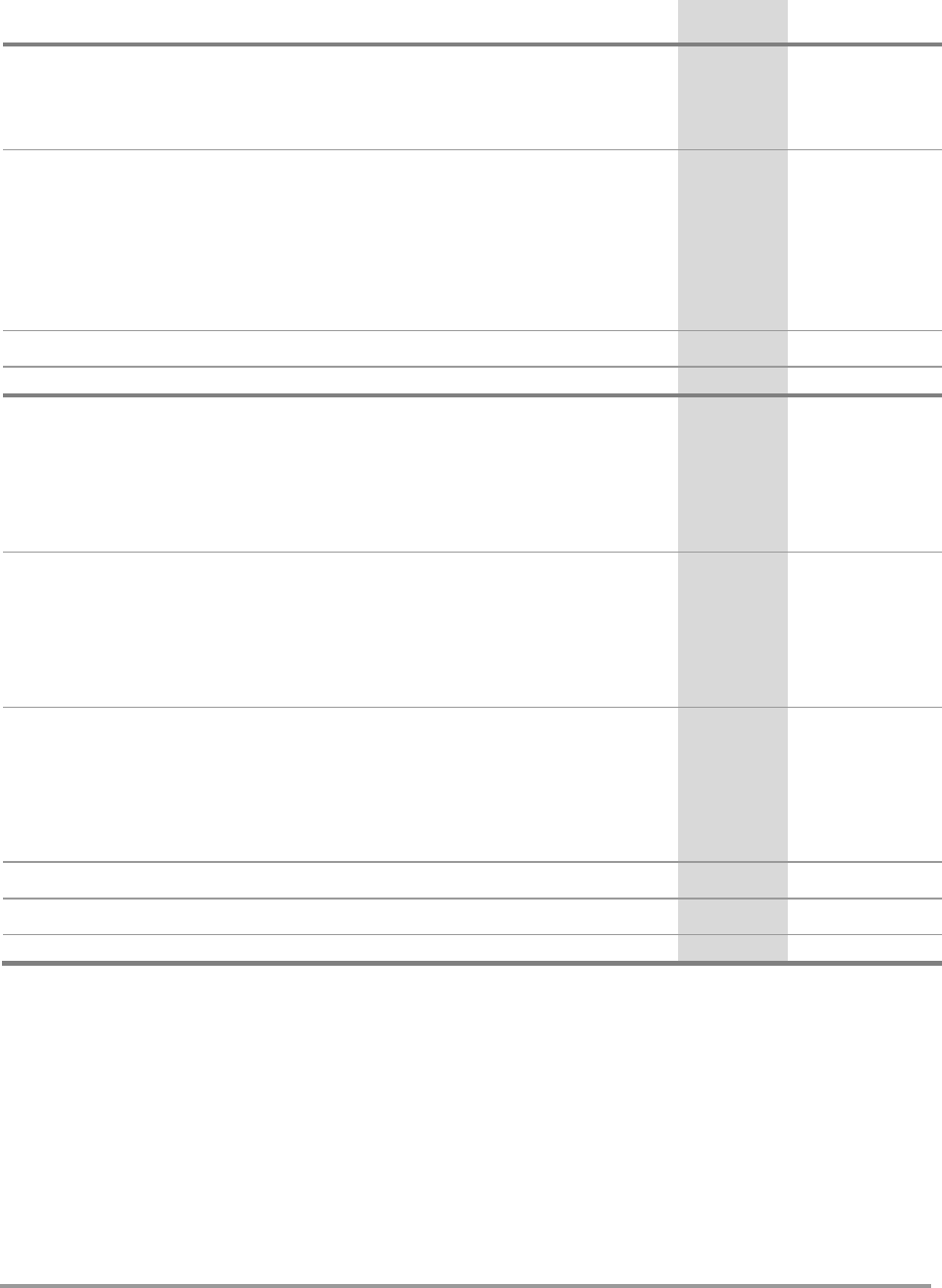
Second Quarter 2016 Page 2 of 16
BIG ROCK BREWERY INC.
Condensed Interim Consolidated Statements of Financial Position
Unaudited
(In thousands of Canadian dollars)
June 30,
2016
December 30,
2015
ASSETS
Non-current assets
Property, plant and equipment
$ 43,514 $ 41,590
Intangible assets
399 456
43,913 42,046
Current
Inventories (Note 9) 5,326 4,935
Accounts receivable (Note 10)
3,280 2,221
Prepaid expenses and other (Note 11)
1,600 1,573
Current taxes receivable
66 —
Cash
311 540
10,583 9,269
Total assets $ 54,496 $ 51,315
LIABILITIES AND SHAREHOLDERS' EQUITY
EQUITY
Shareholders' capital (Note 12) $ 113,121 $ 113,121
Contributed surplus (Note 12 and 13)
1,334 1,255
Accumulated deficit
(77,236)
(76,836)
37,219 37,540
LIABILITIES
Non-current
Long term debt (Note 14) 5,305 3,485
Share based payment liabilities (Note 13)
419 134
Deferred income taxes
4,417 4,399
10,141 8,018
Current
Accounts payable and accrued liabilities (Note 15) 5,190 4,051
Current taxes payable
— 55
Current portion of long term debt (Note 14)
901 404
Bank indebtedness (Note 14)
1,045 1,247
7,136 5,757
Total liabilities and shareholders’ equity $ 54,496 $ 51,315
See accompanying notes to the condensed interim consolidated financial statements

Second Quarter 2016 Page 3 of 16
BIG ROCK BREWERY INC.
Condensed Interim Consolidated Statements of Cash Flow
Unaudited
(In thousands of Canadian dollars)
Three months ended
June 30
Six months ended
June 30
2016 2015 2016 2015
OPERATING ACTIVITIES
Net income (loss) for the period $ 382 $ (473) $ (400) $ (1,097)
Items not affecting cash:
Depreciation and amortization
619 632 1,258 1,142
Loss (gain) on sale of assets
11 (95) (54) (83)
Stock based compensation
139 108 364 4
Deferred income tax (recovery)
260 79 18 (89)
1,411 251 1,186 (123)
Net change in non-cash working capital related
to operations (Note 18)
(1,328) (157) (474) (1,527)
Cash provided by (used in) operating activities
83 94 712 (1,650)
FINANCING ACTIVITIES
Increase (decrease) in bank indebtedness
680 (527) (202) 4,401
Dividend payments
— — — (1,375)
Proceeds from long-term debt
367 1,950 2,317 1,950
Cash provided by financing activities
1,047 1,423 2,115 4,976
INVESTING ACTIVITIES
Purchase of property, plant and equipment
(1,390) (718) (3,165) (3,651)
Purchase of intangibles
(15) (37) (23) (266)
Proceeds from sale of equipment
30 101 132 101
Cash used in investing activities
(1,375) (654) (3,056) (3,816)
Net increase (decrease) in cash (245) 863 (229) (490)
Cash, beginning of period 556 131 540 1,484
Cash, end of period
$ 311 $ 994 $ 311 $ 994
Supplemental cash-flow information
Cash interest paid
$ 93 $ 53 $ 149 $ 72
Cash taxes paid
$ — $ — $ 57 $ 241
See accompanying notes to the condensed interim consolidated financial statements

Second Quarter 2016 Page 4 of 16
BIG ROCK BREWERY INC.
Condensed Interim Consolidated Statements of Changes in Shareholders’ Equity
Unaudited
(In thousands of Canadian dollars)
Share
Capital
Contributed
Surplus
Accumulated
Deficit
Total
Balance as at December 30, 2014 $ 113,121 $ 1,083 $ (75,761)
$ 38,443
Share-based payments — 94 — 94
Total comprehensive income (loss) — — (1,097)
(1,097)
Balance as at June 30, 2015 $ 113,121 $ 1,177 $ (76,858)
$ 37,440
Share-based payments — 78 — 78
Total comprehensive income — — 22
22
Balance as at December 30, 2015 $ 113,121 $ 1,255 $ (76,836)
$ 37,540
Share-based payments — 79 — 79
Total comprehensive income (loss) — — (400)
(400)
Balance as at June 30, 2016 $ 113,121 $ 1,334 $ (77,236)
$ 37,219
See accompanying notes to the condensed interim consolidated financial statements

Second Quarter 2016 Page 5 of 16
1. CORPORATE INFORMATION
Big Rock Brewery Inc. (“Big Rock” or the “Corporation”) is a publicly listed Corporation incorporated in
Canada with limited liability under the legislation of the Province of Alberta and its shares are listed on
the Toronto Stock Exchange and trade under the symbol “BR”.
Big Rock is a regional producer of premium, all-natural craft beers and cider which are sold in six
provinces and two territories in Canada, as well as exported to Korea. The head office, principal
address and records office of the Corporation are located at 5555 – 76
th
Avenue SE, Calgary, Alberta,
T2C 4L8.
These condensed interim consolidated financial statements (the “Financial Statements”) include the
accounts of Big Rock Brewery Inc. and all its wholly owned subsidiaries. Subsidiaries are those
enterprises controlled by the Corporation. The following entities have been consolidated with the Big
Rock financial statements:
Registered
Holding
Functional
Currency
Subsidiary
Big Rock Brewery Inc. Alberta
Parent
Company
Canadian
dollar
Big Rock Brewery Operations Corp. Alberta 100%
Canadian
dollar
Big Rock Brewery Limited Partnership Alberta 100%
Canadian
dollar
Inter-company balances and transactions, and any unrealized gains arising from inter-company
transactions, are eliminated in preparing the consolidated financial statements.
2. BASIS OF PREPARATION
2.1 Statement of compliance
These Financial Statements are unaudited and have been prepared in accordance with IAS 34 Interim
Financial Reporting (“IAS 34”) using accounting policies consistent with the IFRS issued by the
International Accounting Standards Board (“IASB”) and Interpretations of the International Financial
Reporting Interpretations Committee (“IFRIC”).
These Financial Statements should be read in conjunction with Big Rock’s 2015 annual consolidated
financial statements.
2.2 Basis of presentation
These Financial Statements have been prepared on a going concern basis, which contemplates the
realization of assets and settlement of liabilities in the normal course of business.
The Financial Statements have been prepared on the historical cost basis, presented in Canadian
dollars and all values are rounded to the nearest thousand dollars except where otherwise indicated.
2.3 Future accounting pronouncements
The IASB has issued the following pronouncements:
Amendments to IAS 7 Statement of cash flows are effective for annual periods beginning on or
after January 1, 2017. The amendments clarify that entities shall provide disclosures that
enable users of financial statements to evaluate changes in liabilities arising from financing
activities.

Second Quarter 2016 Page 6 of 16
Amendments to IAS 12 Income taxes are effective for annual periods beginning on or after
January 1, 2017. The amendments clarify several aspects of the standard including: deductible
temporary differences relating to unrealized losses on debt instruments, estimations of future
taxable profits, and how an entity assesses deferred tax assets.
IFRS 9 Financial Instruments has been amended, effective for annual periods beginning January
1, 2018. The amended standard replaces IAS 39 Financial Instruments: Recognition and
Measurement and all previous versions of IFRS 9. The standard requires classification of
financial assets on the basis of the reporting entity’s business model objectives for managing
those financial assets and the characteristics of the contractual cash flows. As a result, both
the classification and measurement of certain financial assets may change. Additionally, for
liabilities designated at fair value through profit and loss, fair value changes attributable to
changes in credit risk will be presented through other comprehensive income instead of net
income.
IFRS 15 Revenue from Contracts with Customers has been issued which will be required to be
adopted, with retrospective application, effective for annual periods beginning on or after
January 1, 2018. This standard establishes a five-step model that will apply to revenue earned
from a contract with a customer (with limited exceptions), regardless of the type of revenue
transaction or the industry. The standard also provides a model for the recognition and
measurement of sales of some non-financial assets (e.g., disposals of property, plant and
equipment).
IFRS 16 Leases has been issued which will be required to be adopted effective for annual
periods beginning on or after January 1, 2019. This standard provides a single lessee accounting
model, requiring lessees to recognize assets and liabilities for all leases unless the lease term is
12 months or less or the underlying asset has a low value. Lessors continue to classify leases as
operating or finance, with IFRS 16’s approach to lessor accounting substantially unchanged
from its predecessor, IAS 17.
Early adoption of the above standards, amendment and interpretations is permitted. Big Rock has not
early adopted these; however, the Corporation is currently assessing what impact the application of
these standards or amendments will have on the financial statements of the Corporation.
3. REVENUE RECOGNITION
Three months ended
June 30
Six months ended
June 30
2016 2015 2016 2015
Gross Product Revenues
$ 16,412 $ 14,534 $ 28,375 $ 23,881
Excise Taxes (1,511) (1,255) (2,572) (2,186)
Alberta Gaming and Liquor Commission
(“AGLC”) Commissions
(2,610) (2,174) (4,468) (3,453)
Net Revenue
$ 12,291 $ 11,105 $ 21,335 $ 18,242
Gross Product Revenues include wholesale beer and cider revenues as well as retail store and
restaurant sales. Revenue for Alberta beer and cider represents gross sales to the provincial liquor
control board less excise taxes and commissions arriving at the net proceeds to Big Rock. Beer and
cider revenue for other provincial jurisdictions represents net sales to the liquor control boards, after
excise taxes and commissions. Excise taxes are assessed on beer production at tiered rates up to
$31.22 per hectolitre, and provincial liquor control board commissions cover distributions and other
service charges.

Second Quarter 2016 Page 7 of 16
4. COST OF SALES
The cost of sales of the Corporation is broken down into its cash and non-cash components as follows:
Three months ended
June 30
Six months ended
June 30
2016 2015 2016 2015
Operating expenses
$ 6,211 $ 5,850 $ 11,201 $ 9,188
Depreciation and amortization 518 467 987 865
Cost of sales
$ 6,729 $ 6,317 $ 12,188 $ 10,053
5. SELLING EXPENSES
The selling expenses for the Corporation are broken down as follows:
Three months ended
June 30
Six months ended
June 30
2016 2015 2016 2015
Delivery and distribution costs
$ 967 $ 921 $ 1,694 $ 1,574
Salaries and benefits 860 776 1,712 1,583
Marketing
294 290 558 506
Regional sales
960 1,381 1,962 2,220
Community sponsorship and other
260 388 438 594
Selling expenses
$ 3,341 $ 3,756 $ 6,364 $ 6,477
6. GENERAL AND ADMINISTRATIVE EXPENSES
The general and administrative expenses for the Corporation are broken down as follows:
Three months ended
June 30
Six months ended
June 30
2016 2015 2016 2015
Salaries and benefits
(1)
$ 767 $ 578 $ 1,541 $ 1,217
Professional fees 155 138 316 314
Reporting and filing fees
32 25 74 82
Insurance
57 62 112 119
Building maintenance and taxes
238 128 501 348
Bank charges
36 20 81 83
Office, administrative and other
179 220 349 407
General and administrative expenses
$ 1,464 $ 1,171 $ 2,974 $ 2,570
(1) For the three and six months ended June 30, 2016 salaries and benefits included stock option expense of $nil (2015 – $94) and
$79 (2015 – $94), respectively. Also included, for the three and six months ended June 30, 2016, is a stock appreciation rights
expense of $139 (2015 – $14) and $285 (2015 – reduction in expense of $90), respectively.
7. FINANCE EXPENSES
The finance expenses for the Corporation are broken down as follows:
Three months ended
June 30
Six months ended
June 30
2016 2015 2016 2015
Interest on long-term debt
$ 91 $ 26 $ 136 $ 26
Interest on operating facility 1 46 13 63
Finance expenses
$ 92 $ 72 $ 149 $ 89
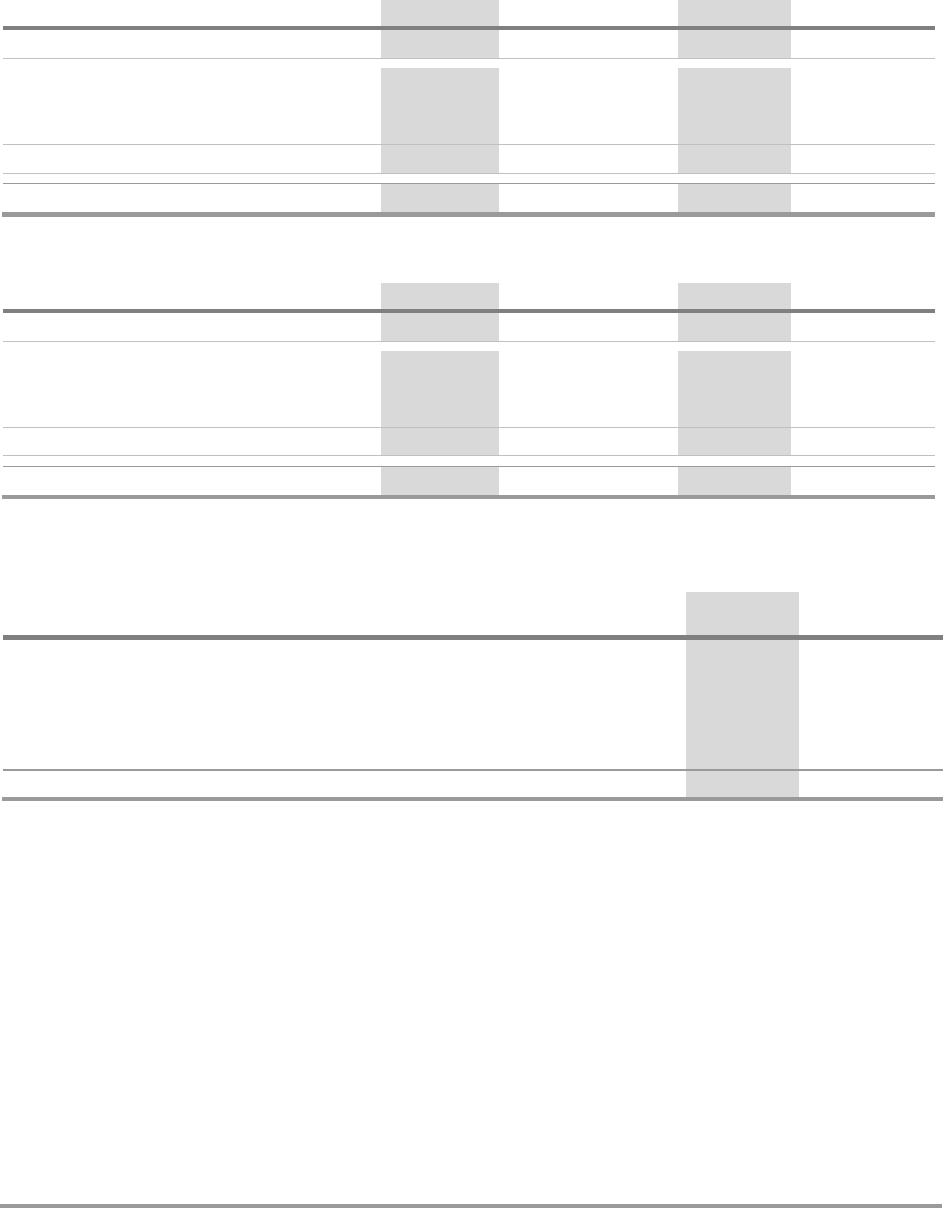
Second Quarter 2016 Page 8 of 16
8. INCOME (LOSS) PER SHARE
The calculation of income (loss) per share for the relevant periods is based on the following data:
Three months ended
June 30
Six months ended
June 30
Basic
2016 2015 2016 2015
Net income (loss)
$ 382 $ (473) $ (400) $ (1,097)
Shares outstanding, beginning of the period
6,875,928 6,875,928 6,875,928 6,875,928
Weighted average # of shares issued during
the period
— — — —
Basic # shares outstanding during the period
6,875,928 6,875,928 6,875,928 6,875,928
Basic income (loss) per share
$ 0.06 $ (0.07) $ (0.06) $ (0.16)
Three months ended
June 30
Six months ended
June 30
Diluted
2016 2015 2016 2015
Net income (loss)
$ 382 $ (473) $ (400) $ (1,097)
Basic # shares outstanding during the period
6,875,928 6,875,928 6,875,928 6,875,928
Weighted average # of shares issuable on
dilutive options, during the period
— — — —
Diluted # shares outstanding during the period
6,875,928 6,875,928 6,875,928 6,875,928
Diluted income (loss) per share
$ 0.06 $ (0.07) $ (0.06) $ (0.16)
9. INVENTORIES
The inventories for the Corporation are categorized as follows:
June 30,
2016
December
30, 2015
Raw materials and glass containers
$ 1,675 $ 1,447
Brews in progress 1,095 1,091
Finished product
2,097 1,901
Consignment product
288 315
Dry goods store (resale goods)
171 181
$ 5,326 $ 4,935
During the three and six months ended June 30, 2016, charges of $37 (2015 - $71) and $68 (2015 - $98),
respectively, were recorded to net income relating to obsolete, damaged or unsellable inventory.
During the three and six months ended June 30, 2016, charges of $164 (2015 - $64) and $343 (2015 -
$124), respectively, were recorded to net income relating to promotional and resale goods and
damaged finished goods inventory.
In the three and six months ended June 30, 2016, there were no reversals of amounts previously
charged to income in respect of write-downs of inventory (2015 - $nil).
Finished goods inventory includes $140 (December 30, 2015 – $155) of depreciation charges on
production equipment used to convert raw materials to finished goods.
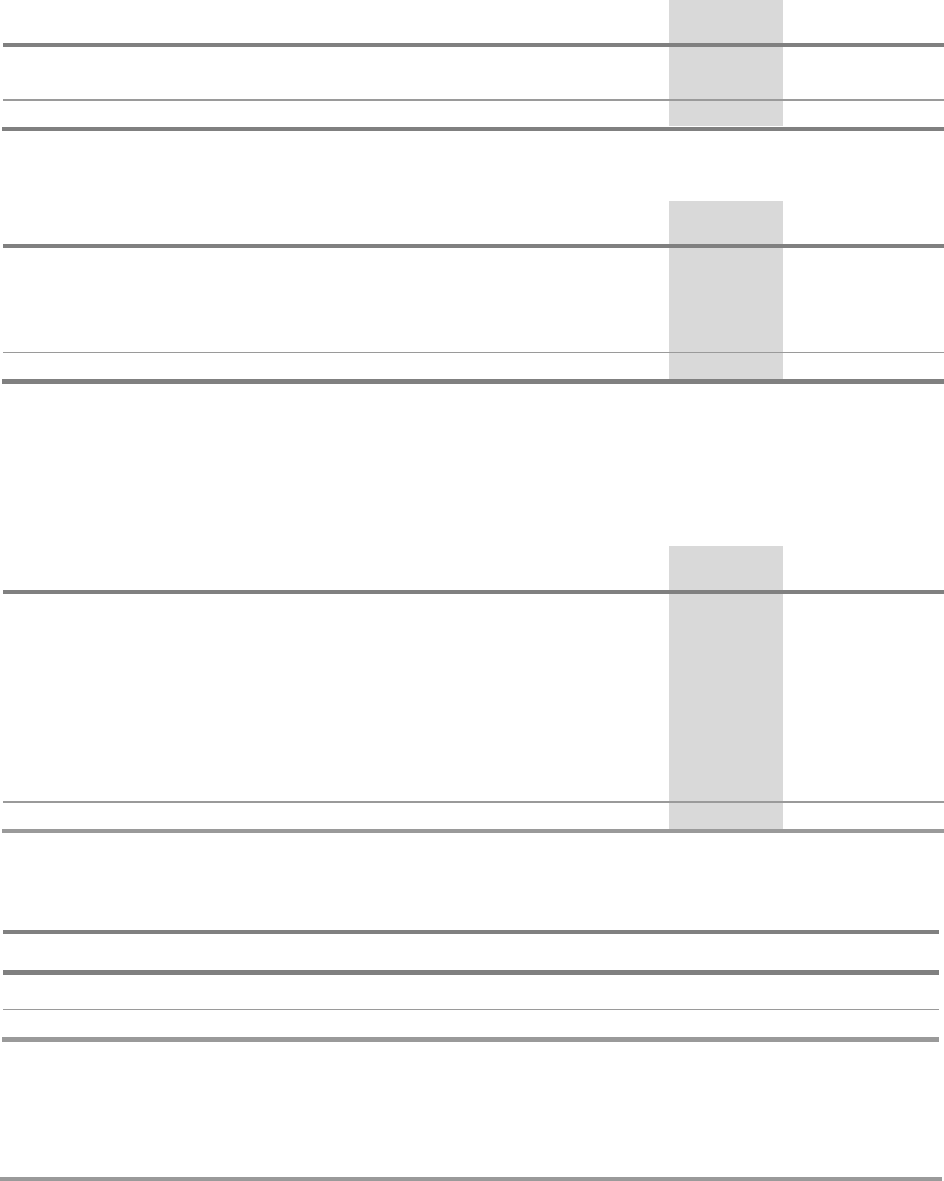
Second Quarter 2016 Page 9 of 16
10. ACCOUNTS RECEIVABLE
The Corporation’s receivables arise from three main sources: trade receivables from the sale of beer
and cider to provincial liquor boards, supplier rebates and other amounts. Other receivables include
amounts due from sales to international customers and GST balances. The accounts receivable
balances are broken down as follows:
June 30,
2016
December 30,
2015
Provincial liquor boards
$ 2,903 $ 2,033
Other receivables 377 188
Total accounts receivable
$ 3,280 $ 2,221
Below is an aged analysis of the Corporation’s trade and other receivables:
June 30,
2016
December 30,
2015
Less than 30 days
$ 3,063 $ 938
30 – 60 days 140 1,276
60 – 90 days
20
—
Over 90 days
57 7
Total accounts receivable
$ 3,280 $ 2,221
The Corporation holds no collateral for any receivable amounts outstanding as at June 30, 2016.
11. PREPAID EXPENSES AND DEPOSITS
The prepaid expenses and deposits for the Corporation are categorized as follows:
June 30,
2016
December 30,
2015
Community sponsorship
$ 234 $ 59
Prepaid insurance 224 92
Property taxes
38 —
Equipment deposits, rental and maintenance
1,002 1,142
Consulting
37 114
Promotional materials
12 96
Employee benefits
3 3
Other
50 67
$ 1,600 $ 1,573
12. SHARE CAPITAL
June 30, 2016 December 30, 2015
# of shares $ Amount # of shares $ Amount
Outstanding at beginning of period 6,875,928 113,121
6,875,928 113,121
Outstanding at end of period 6,875,928 113,121
6,875,928 113,121
Big Rock is authorized to issue an unlimited number of common shares with no par value.
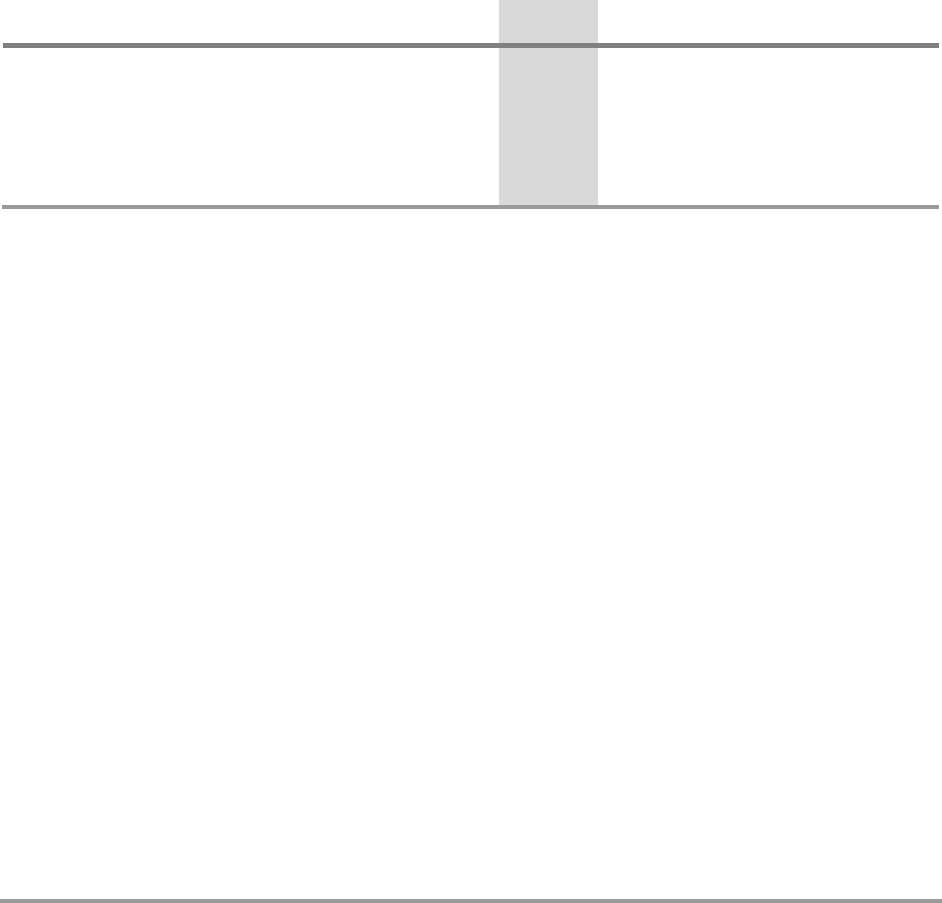
Second Quarter 2016 Page 10 of 16
13. SHARE-BASED PAYMENTS
13.1 Share option plan
The Corporation has a share option plan which permits the Board of Directors of the Corporation to
grant options to acquire common shares of the Corporation at the volume weighted average closing
price for the five days preceding the date of grant. The Compensation Committee determines and
makes recommendations to the Board of Directors as to the recipients of, and nature and size of,
share-based compensation awards in compliance with applicable securities law, stock exchange and
other regulatory requirements – including the terms of the option plan. The Corporation is authorized
to issue options for a maximum of 10% of the issued and outstanding common shares pursuant to the
share option plan.
The general terms of share options granted under the amended plan include a maximum exercise
period of 5 years and vesting immediately.
The weighted average fair value of the options issued at the grant date was estimated using the Black-
Scholes option pricing model. The weighted average assumptions used for the calculations were:
March
2016
September
2015
May
2015
September
2014
Weighted average fair value per
option
1.35 1.33 1.60 1.54
Risk-free interest rate (%) 0.65 0.65 0.89 1.42
Expected life of the options (years)
4 4 4 4
Dividend rate (%)
0.00 0.00 0.00 5.06
Volatility in the price of the
Corporation's shares (%)
34.7 29.4 28.7 22.4
A share-based compensation charge of $79 (2015 - $94) for the options granted in the six months ended
June 30, 2016 was recognized in statement of comprehensive income. Share-based compensation costs
have been included in general and administrative expenses.
13.2 Share appreciation rights plans
In March 2012, the Corporation introduced a share appreciation rights (“SAR”) plan as a component of
overall compensation of directors, officers and employees. These SARs vest immediately and are
exercisable for five years thereafter.
At the end of each reporting period, the fair value of the SARs, as determined by the Black-Scholes
model, is recorded as a liability on the balance sheet and recorded as compensation expense.
As at June 30, 2016, 470,900 SARs were outstanding (December 30, 2015 – 391,900). During the three
months ended June 30, 2016, no SARs were issued (2015 – 57,000), no SARs were exercised (2015 – nil)
and no SARs expired (2015 – nil). As at June 30, 2016, the fair value of the SARs was calculated and
resulted in a liability of $419 (December 30, 2015 - $134) and an expense of $285 being recorded in
general and administrative expenses (December 30, 2015 – recovery of $82).
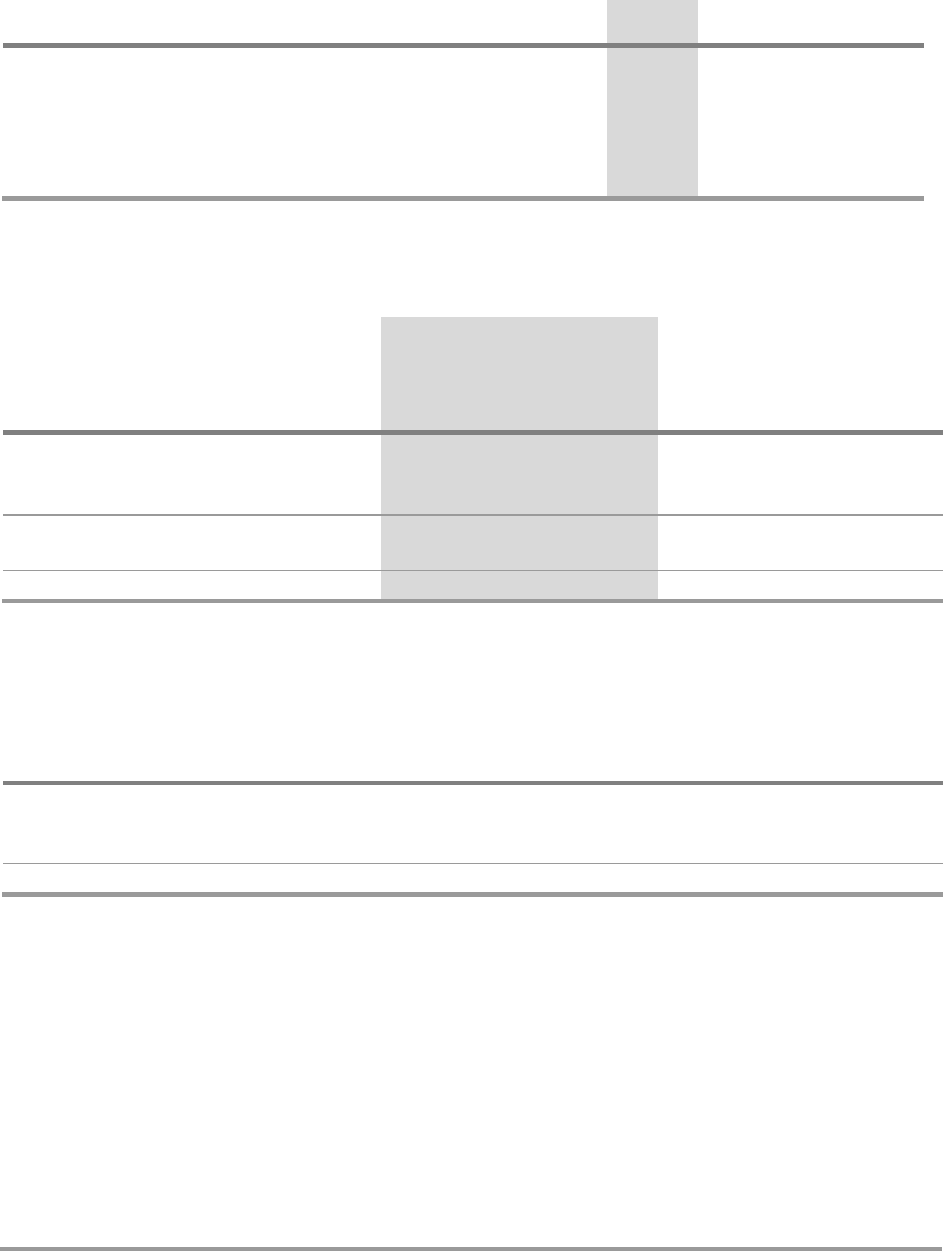
Second Quarter 2016 Page 11 of 16
At June 30, 2016, the weighted average fair value of the SARs issued at the grant date was estimated
using the Black-Scholes option pricing model. The weighted average assumptions used for the
calculations were:
March
2016
September
2015
May
2015
Weighted average fair value per SAR
2.31 1.92 1.31
Risk-free interest rate (%)
0.56 0.55 0.54
Expected life of the SAR (years)
4.70 4.20 3.87
Dividend rate (%)
0.00 0.00 0.00
Volatility in the price of the
Corporation's shares (%)
34.8 34.8 34.8
13.3 Outstanding share options
The following is a summary of option transactions under the Corporation’s share option plan:
2016 2015
# of options
Weighted
average
exercise
price # of options
Weighted
average
exercise
price
Balance, beginning of year
517,000 $ 13.10 508,000 $ 15.22
Expired (17,500) 16.60 — —
Issued
58,500 5.12 — —
Balance, March 31
558,000 $ 12.15 508,000 $ 15.22
Issued — — 58,500 $ 7.46
Balance, June 30
558,000 $ 12.15 566,500 $ 14.42
The following table summarizes information about share options outstanding and exercisable at June
30, 2016:
Exercise price
# of Options
outstanding at
June 30, 2016
Weighted
average
remaining
contractual
life (years)
Weighted
average
exercise
price
# of Options
exercisable at
June 30, 2016
$5.12 to $12.19 193,000 3.88 $ 6.65 193,000
$12.20 to $14.98 189,500 1.12 $ 13.88 189,500
$14.99 to $18.06 175,500 2.70 $ 16.34 175,500
Balance, June 30
558,000 2.57 $ 12.15 558,000
14. BANK INDEBTEDNESS AND LONG-TERM DEBT
On March 29, 2016, Big Rock signed a commitment letter to revise and extend the existing $5 million
revolving operating loan facility and $6 million 5-year term loan facility which is available for general
operating purposes and funding capital expenditure requirements. For prime-based loans, interest will
be payable at the financial institution’s prime plus 2.0–4.0 percent; for guaranteed notes, the
acceptance fee is payable at 3.75 percent; and for letters of credit, the fee is payable at 3.75 percent
with a minimum fee of $100. Both facilities mature after a term of 5 years and any undrawn amounts
under the facility will expire on March 29, 2021, if no extension has been granted. Collateral for these
borrowings is a general assignment of Big Rock’s assets.
The facility imposes a number of positive and negative covenants on Big Rock, including the
maintenance of certain financial ratios. Big Rock was in compliance with all covenants at June 30,
2016.

Second Quarter 2016 Page 12 of 16
As at June 30, 2016, $3,700 (December 30, 2015 - $1,850) was drawn on the term loan facility and
$1,045 (December 30, 2015 - $1,247) was outstanding on the operating loan facility.
On July 9, 2015 Big Rock signed a commitment letter for a $2.5 million lease financing facility which is
available to finance the purchase of equipment relating to Big Rock’s Ontario expansion. Interest will
be charged at the financial institution’s prime plus 3.67 per cent. The facility matures after a term of 5
years. As at June 30, 2016, $2,506 (December 30, 2015 - $2,039) was drawn on the facility.
15. ACCOUNTS PAYABLE AND ACCRUED LIABILITIES
Accounts payable and accrued liabilities of the Corporation are principally comprised of amounts
outstanding for trade purchases relating to production, selling, and general and administrative
activities. The usual credit period taken for trade purchases is between 30 to 90 days.
The following is an aged analysis of the trade and other payables:
June 30,
2016
December 30,
2015
Less than 30 days
$ 5,126 $ 4,045
30 – 60 days 19 —
60 – 90 days
12 —
Over 90 days
33 6
Total accounts payable and accrued liabilities
$ 5,190 $ 4,051
16. DIVIDENDS PAYABLE
In March 2015, Big Rock announced the suspension of the Corporation’s quarterly dividend until further
notice.
In determining dividend levels, if any, in the future, the Board will consider the financial performance,
capital plans, growth opportunities, expectations of future economic conditions and other factors.
Since the level of dividends is highly dependent upon cash flow generated from operations, which
fluctuates significantly in relation to changes in financial and operational performance, commodity
prices, interest and exchange rates and many other factors, future dividends cannot be assured.
Dividends are subject to the risk factors described herein and in the Corporation’s public disclosure
documents including its current Annual Information Form.
17. CAPITAL RISK MANAGEMENT
The Corporation includes as capital its common shares plus short-term and long-term debt, net of cash
balances, and has no externally imposed capital requirements. The Corporation’s objectives are to
safeguard the Corporation’s ability to continue as a going concern, in order to support the
Corporation’s normal operating requirements and to maintain a flexible capital structure which
optimizes the costs of capital at an acceptable risk. This allows management to maximize the
profitability of its existing assets and create long-term value and enhance returns for its shareholders.
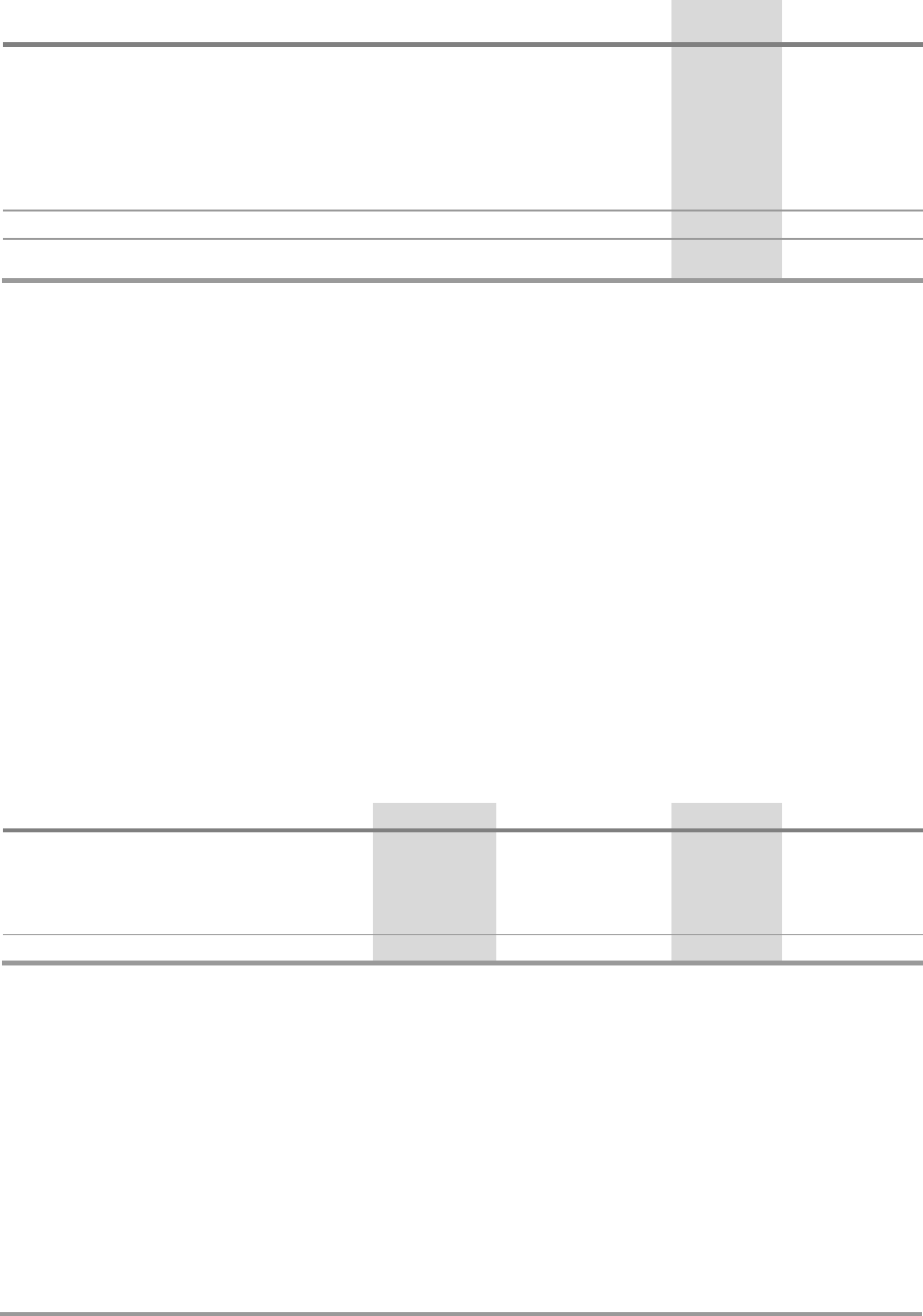
Second Quarter 2016 Page 13 of 16
June 30,
2016
December 30,
2015
Bank indebtedness (cash)
$ (311) $ (540)
Total debt
7,251
5,136
Shareholders’ equity:
Shareholders’ capital
113,121 113,121
Contributed surplus
1,334 1,255
Accumulated deficit
(77,236) (76,836)
Total shareholders’ equity
37,219 37,540
Total capitalization (total debt plus
shareholders’ equity, net of cash balances)
$ 44,159 $ 42,136
The Corporation manages the capital structure through prudent levels of borrowing, cash-flow
forecasting, and working capital management, and makes adjustments to it in light of changes in
economic conditions and the risk characteristics of the underlying assets. In order to maintain or adjust
the capital structure, the Corporation may issue new shares, issue new debt, acquire or dispose of
assets or adjust the amount of cash and cash equivalents. In order to facilitate the management of its
capital requirements, the Corporation prepares annual expenditure budgets, which are approved by the
Board of Directors. These budgets are updated as necessary depending on various factors, including
capital deployment, results from operations, and general industry conditions.
In addition, the Corporation monitors its capital using ratios of (i) earnings before interest, taxes,
depreciation and amortization (“EBITDA”) to net debt and (ii) EBITDA to interest, debt repayments and
dividends. EBITDA to interest, debt repayments and dividends is calculated by dividing the combined
interest, debt repayments and dividend amounts by EBITDA and EBITDA to net debt is calculated by
dividing debt minus cash by EBITDA.
These capital policies, which remain unchanged from prior periods, provide Big Rock with access to
capital at a reasonable cost.
18. CHANGE IN NON-CASH WORKING CAPITAL
Three months ended
June 30
Six months ended
June 30
2016 2015 2016 2015
Accounts payable and accrued liabilities
$ (151) $ 1,350 $ 1,018 $ 1,583
Inventory (155) (19) (406) (993)
Accounts receivable
(688) (1,008) (1,059) (1,327)
Prepaid expenses
(334) (480) (27) (790)
Total change in non-cash working capital
$ (1,328) $ (157) $ (474) $ (1,527)
19. SEGMENTED INFORMATION
For management purposes, the Corporation is organised into operating segments based on its products,
services, location and distribution methods. Ten operating segments have been identified. These
segments have been aggregated into two aggregated reportable segments, as follows:
The wholesale segment, which manufactures and distributes beer and cider to, and through,
provincial liquor boards, which is subsequently sold on to end consumers;
The retail segment, which sells beverages, food and merchandise to end consumers on
premises owned and/or operated by the Corporation.
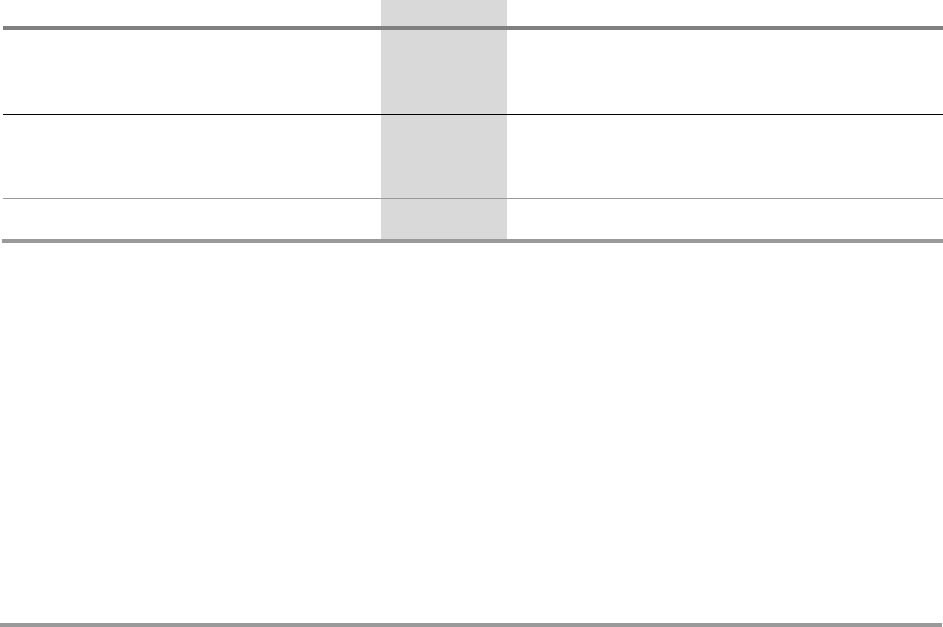
Second Quarter 2016 Page 14 of 16
The wholesale segment has been aggregated based on the fact that these segments have similar
production processes and types of customers, as well as products being shipped to customers instead of
being sold on-site.
The retail segment has been aggregated based on the fact that these segments all sell products directly
to the end consumer and serve these consumers on a premise owned or operated by Big Rock.
Executive management monitors the operating results of its operating segments separately for the
purpose of making decisions about resource allocation and performance assessment. Segment
performance is evaluated on a number of measures, the most significant being profit or loss. This is
measured consistently with profit or loss in the consolidated financial statements. The Corporation’s
general and administrative expenses, financing (including finance costs and finance income) and
income taxes are managed on a Corporate basis and are not allocated to operating segments.
Transfer prices between operating segments are on an arm’s length basis in a manner similar to
transactions with third parties.
Adjustments and eliminations
Operating assets and liabilities are managed on a Corporate basis.
General and administrative expenses, current taxes, deferred taxes and capital expenditures are not
allocated to the above segments as they are also managed on a Corporate basis.
Inter-segment revenues are eliminated on consolidation and reflected in the “adjustments and
eliminations” column. All other adjustments and eliminations are part of detailed reconciliations
presented further below.
Reconciliation of profit
Three months ended
June 30
Six months ended
June 30
2016 2015 2016 2015
Segment profit
$ 2,221 $ 1,032 $ 2,783 $ 1,712
General and administrative expenses
1,464
1,171
2,974
2,570
Depreciation and amortization
101
165
271
277
Operating profit (loss)
656 (304) (462) (1,135)
Finance expense (income)
92 72 149 89
Other income
3 142 82 143
Profit (loss) before tax per consolidated
statement of comprehensive income
$ 567 $ (234) $ (529) $ (1,081)

Second Quarter 2016 Page 15 of 16
Profit by Segment
Three Months Ended June 30
Wholesale Retail Total segments
Adjustments and
eliminations Consolidated
2016 2015 2016 2015 2016 2015 2016 2015 2016 2015
Revenue
External customers $ 11,746 $ 10,532 $ 545 $ 573 $ 12,291 $ 11,105 $ — $ — $ 12,291 $ 11,105
Inter-segment 94 60 — — 94 60 (94) (60)
— —
Total revenue 11,840 10,592 545 573 12,385 11,165 (94) (60)
12,291 11,105
External cost of goods sold 6,277 5,741 452 576 6,729 6,317 — — 6,729 6,317
Inter-segment — — 94 60 94 60 (94) (60)
— —
Total cost of goods sold 6,277 5,741 546 636 6,823 6,377 (94) (60)
6,729 6,317
Gross profit 5,563 4,851 (1) (63) 5,562 4,788 — — 5,562 4,788
Selling expenses 3,337 3,751 4 5 3,341 3,756 — — 3,341 3,756
Segment profit $ 2,226 $ 1,100 $ (5) $ (68) $ 2,221 $ 1,032 $ — $ — $ 2,221 $ 1,032
Six Months Ended June 30
Wholesale Retail Total segments
Adjustments and
eliminations Consolidated
2016 2015 2016 2015 2016 2015 2016 2015 2016 2015
Revenue
External customers $ 20,294 $ 17,596 $ 1,041 $ 646 $ 21,335 $ 18,242 $ — $ — $ 21,335 $ 18,242
Inter-segment 127 78 — — 127 78 (127) (78)
— —
Total revenue 20,421 17,674 1,041 646 21,462 18,320 (127) (78)
21,335 18,242
External cost of goods sold 11,236 9,444 952 609 12,188 10,053 — — 12,188 10,053
Inter-segment — — 127 78 127 78 (127) (78)
— —
Total cost of goods sold 11,236 9,444 1,079 687 12,315 10,131 (127) (78)
12,188 10,053
Gross profit 9,185 8,230 (38) (41) 9,147 8,189 — — 9,147 8,189
Selling expenses 6,351 6,472 13 5 6,364 6,477 — — 6,364 6,477
Segment profit $ 2,834 $ 1,758 $ (51) $ (46) $ 2,783 $ 1,712 $ — $ — $ 2,783 $ 1,712

Second Quarter 2016 Page 16 of 16
20. LEASES
Big Rock has entered into operating lease agreements for storage facilities, warehouses, breweries, and
retail locations. The remaining terms of these leases range between 4 and 10 years. Certain leases
contain extension and renewal options.
Future minimum lease payments due as at June 30, 2016 are:
Within one year
$ 1,197
After one year but not more than five years 4,775
More than five years
2,549
$ 8,521
As at June 30, 2016, lease payments of $441 (2015 - $299) were recognized as expense in the
statement of comprehensive income.
21. COMPARATIVE AMOUNTS
Certain prior year amounts have been reclassified to conform to the current year presentation.
22. APPROVAL OF THE FINANCIAL STATEMENTS
The Financial Statements of Big Rock Brewery Inc. for the three months ended June 30, 2016 were
approved and authorized for issue by the Audit Committee on August 4, 2016.
